
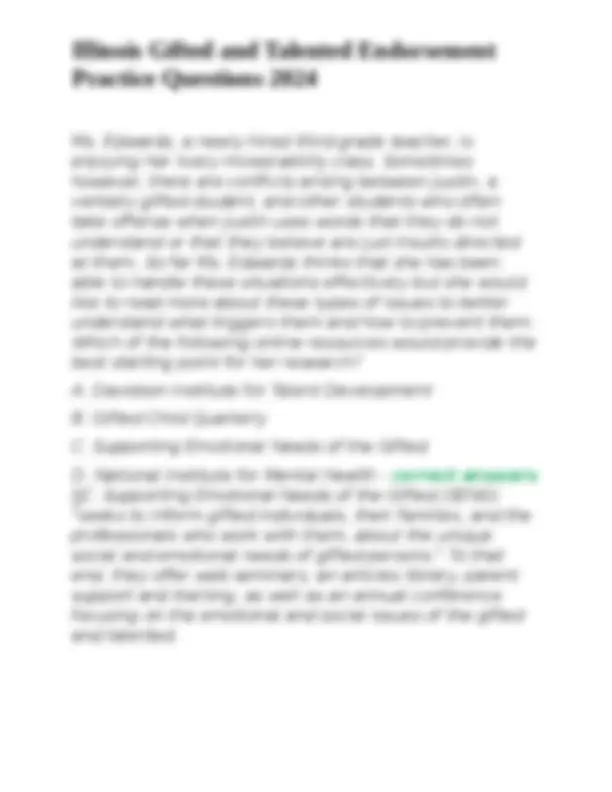
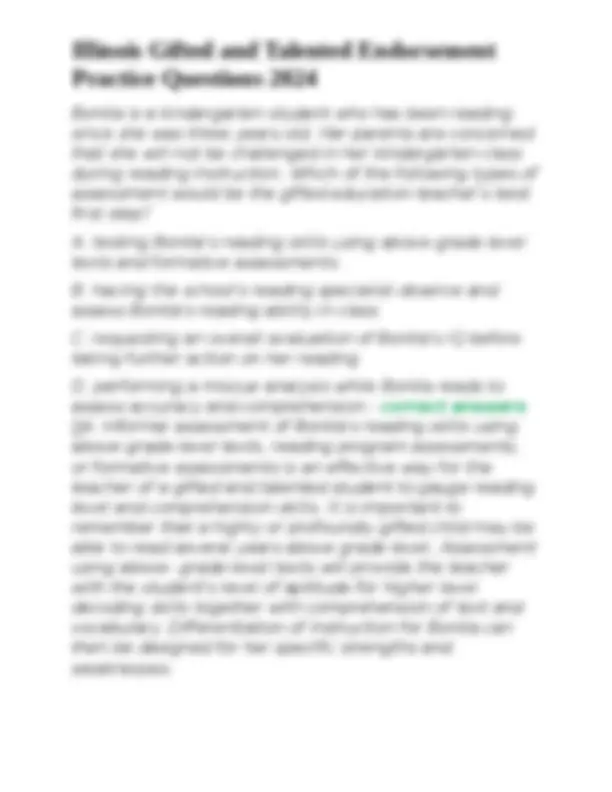
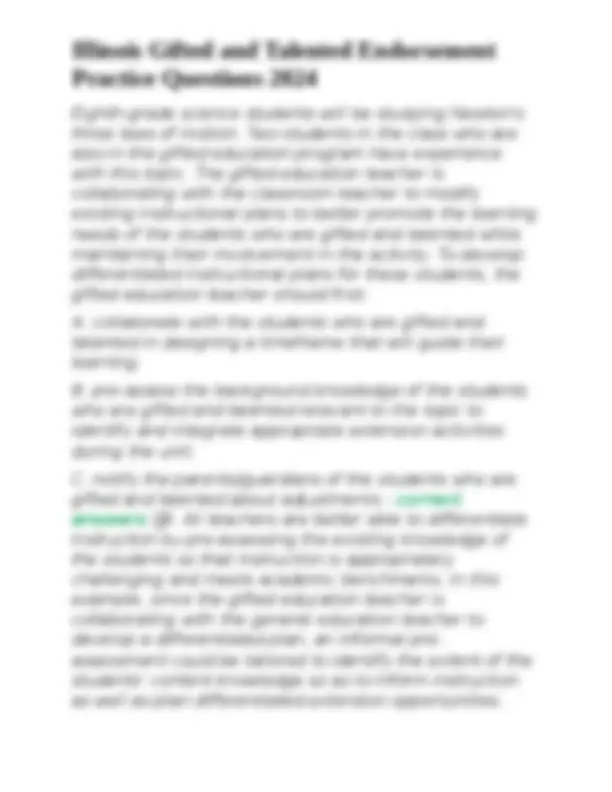
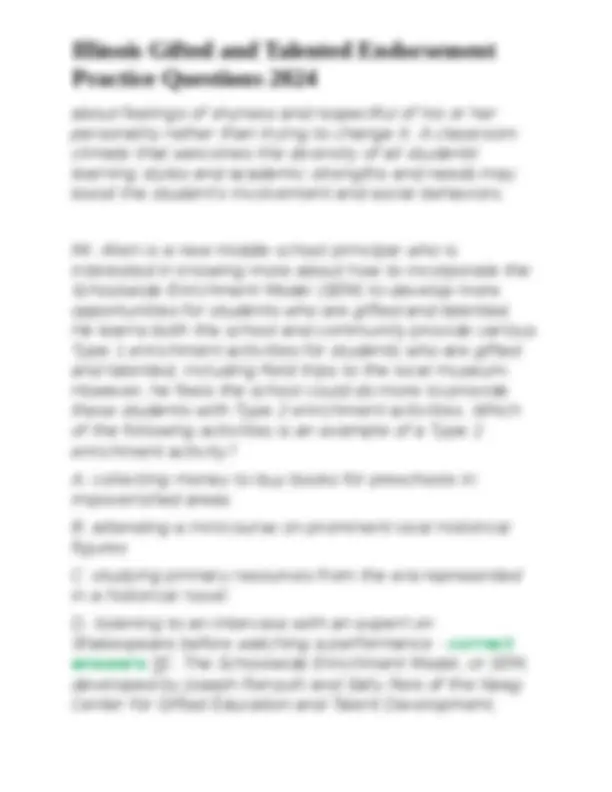
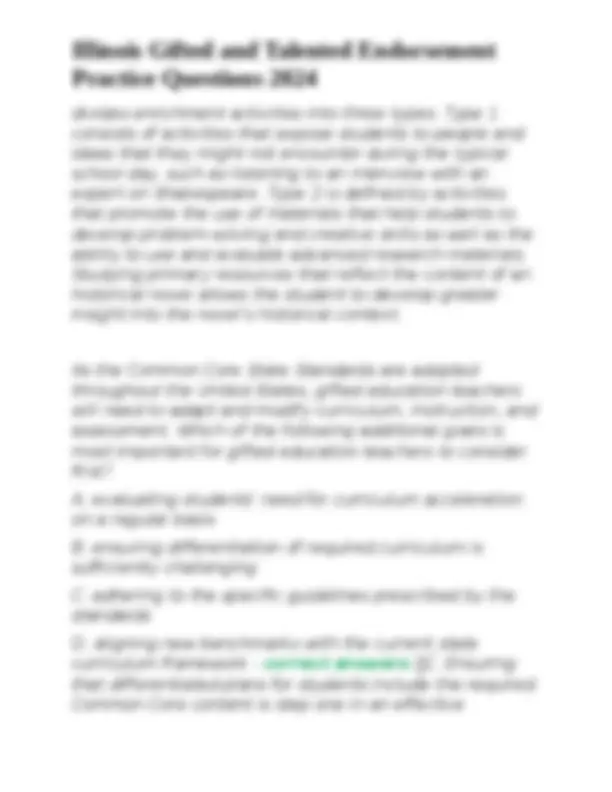
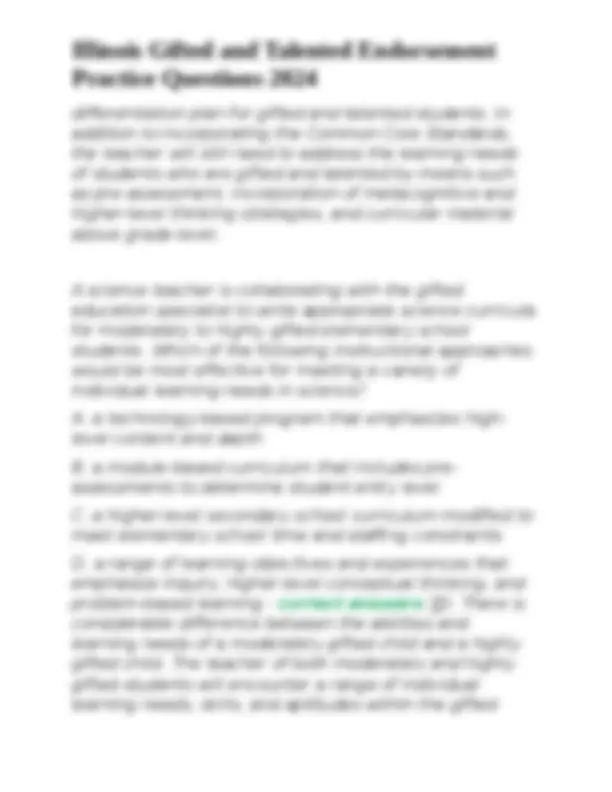
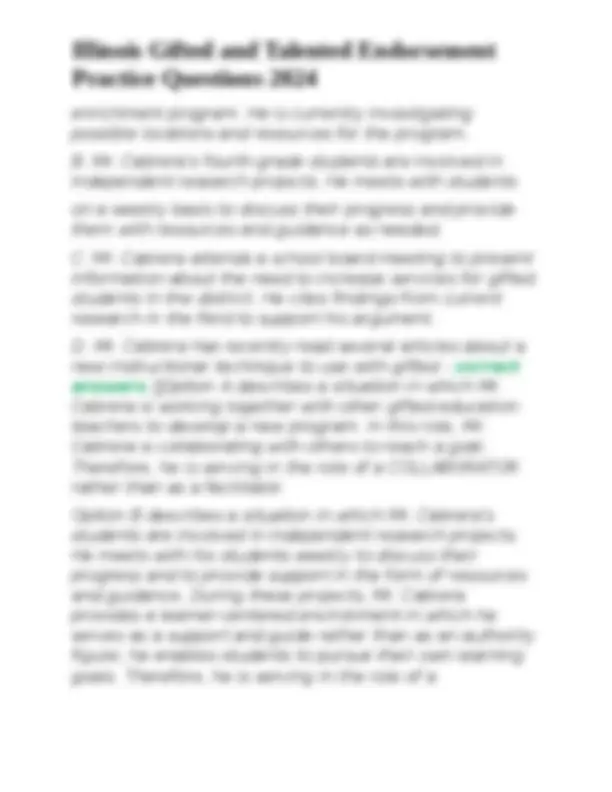
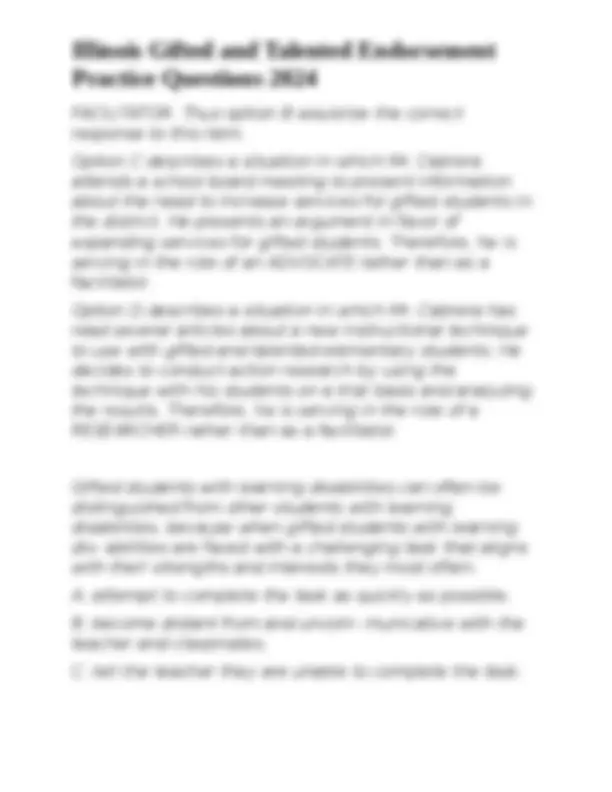
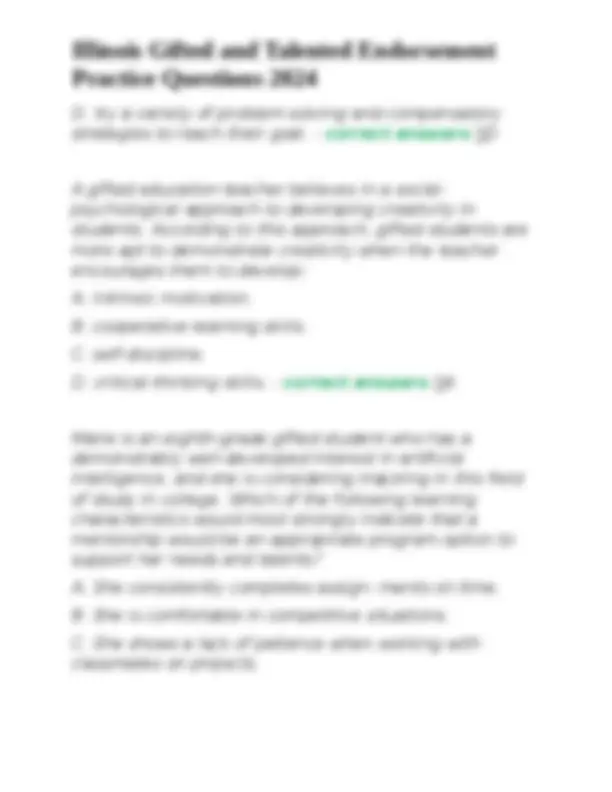
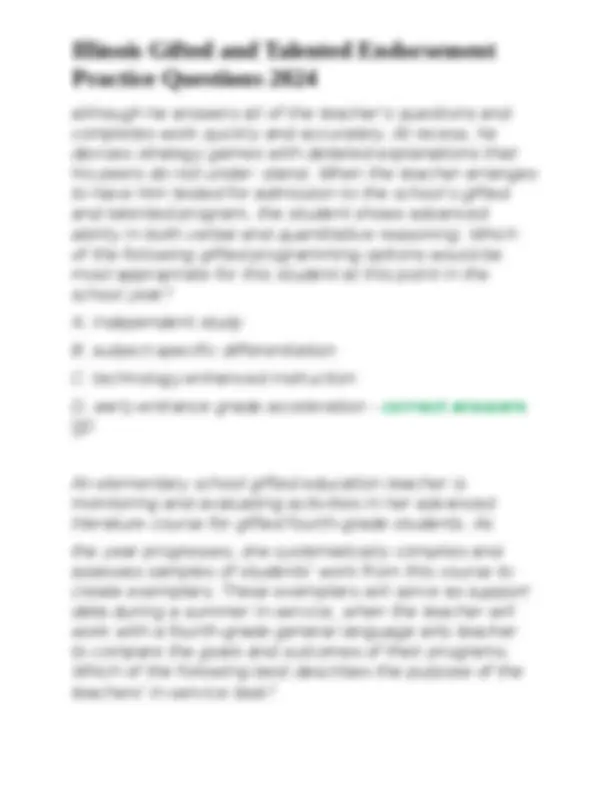
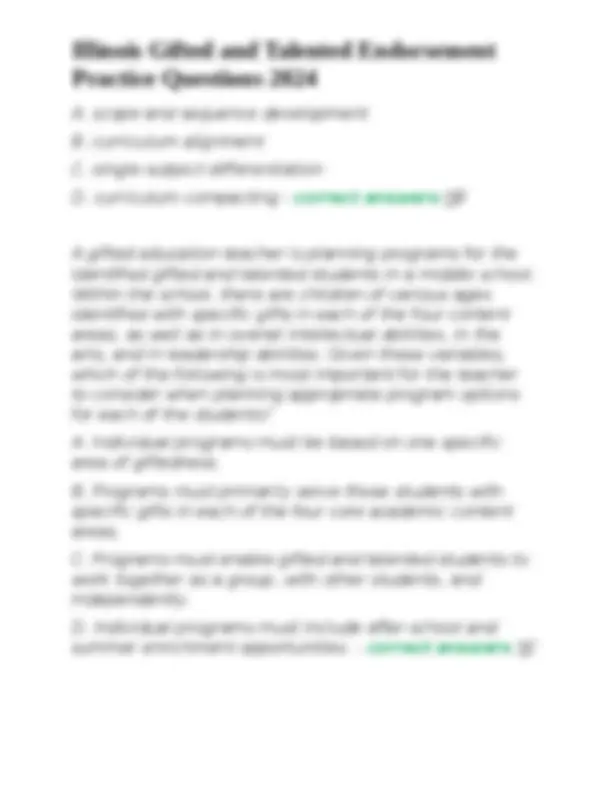
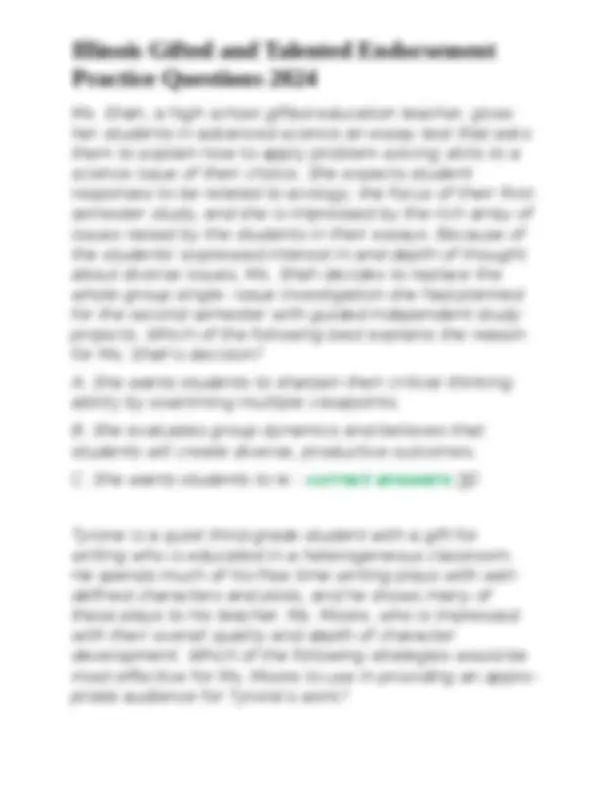

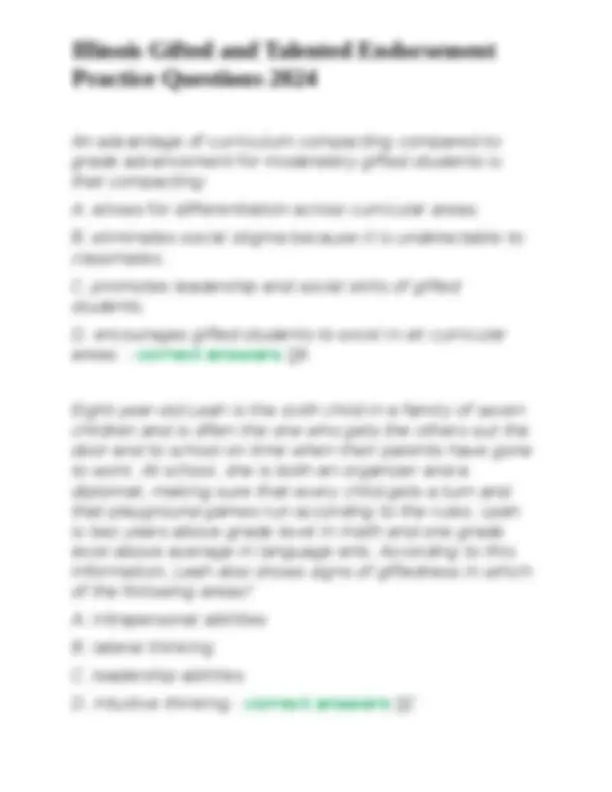
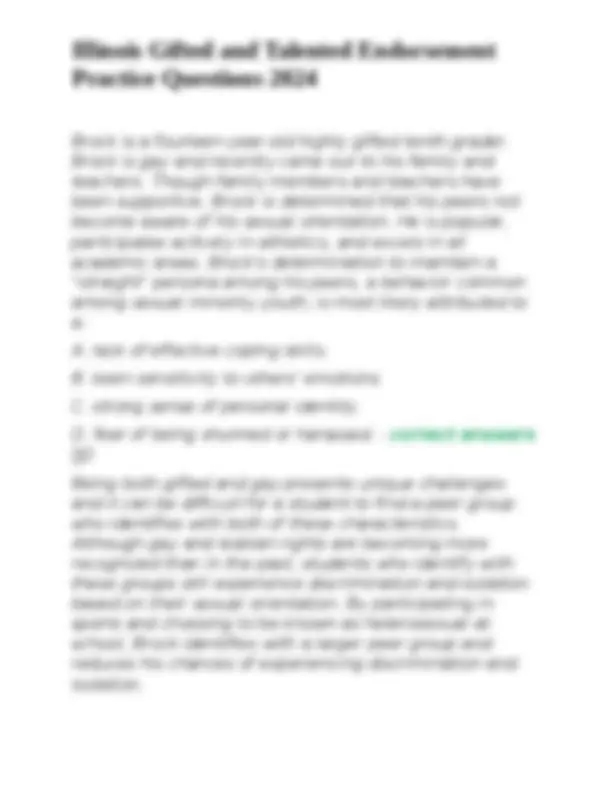
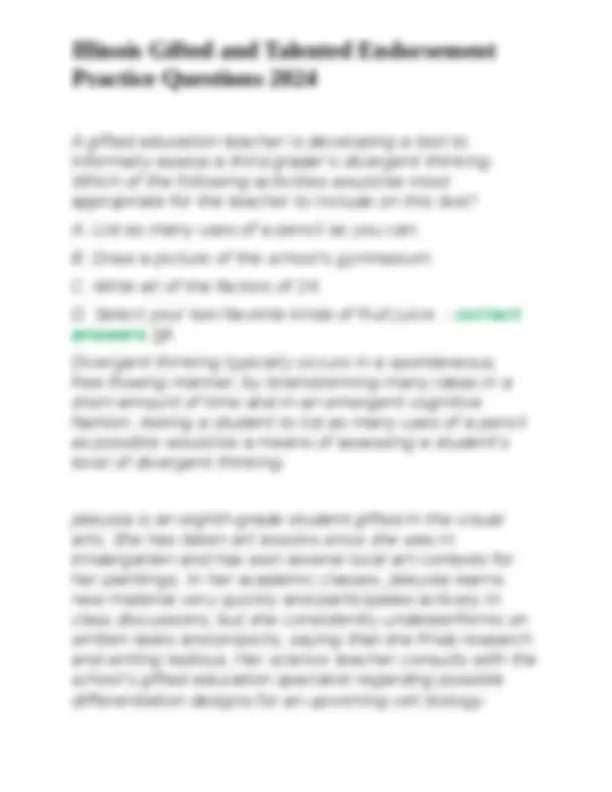
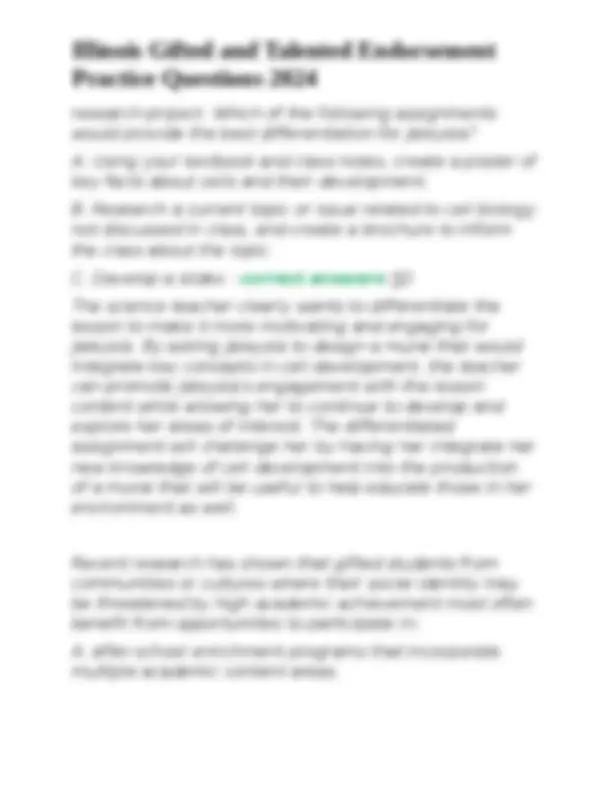
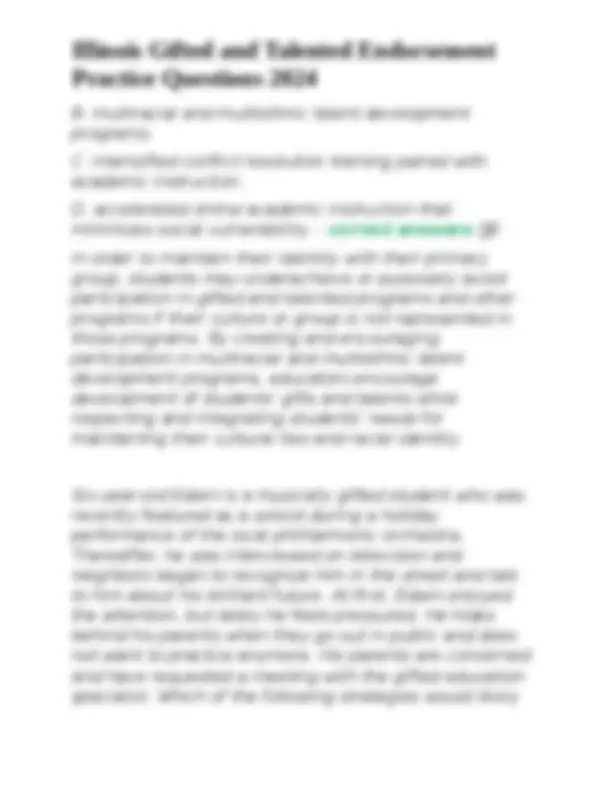
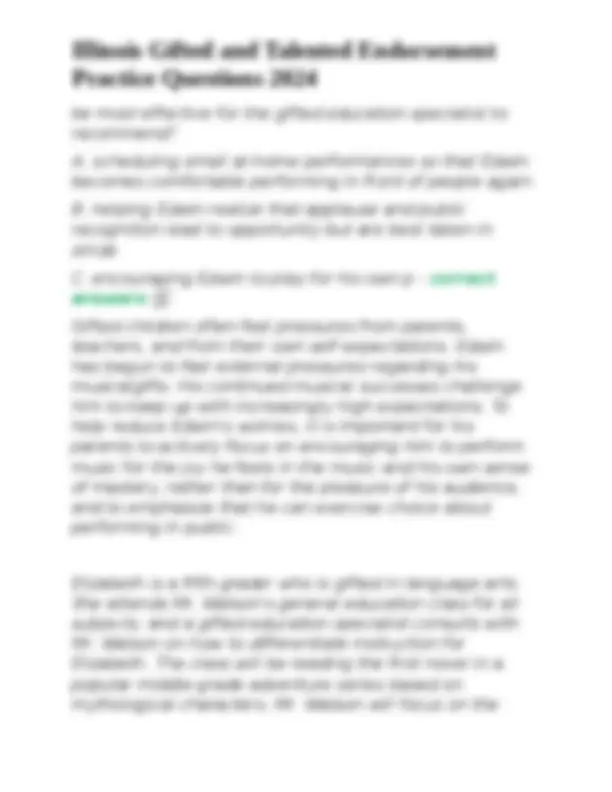
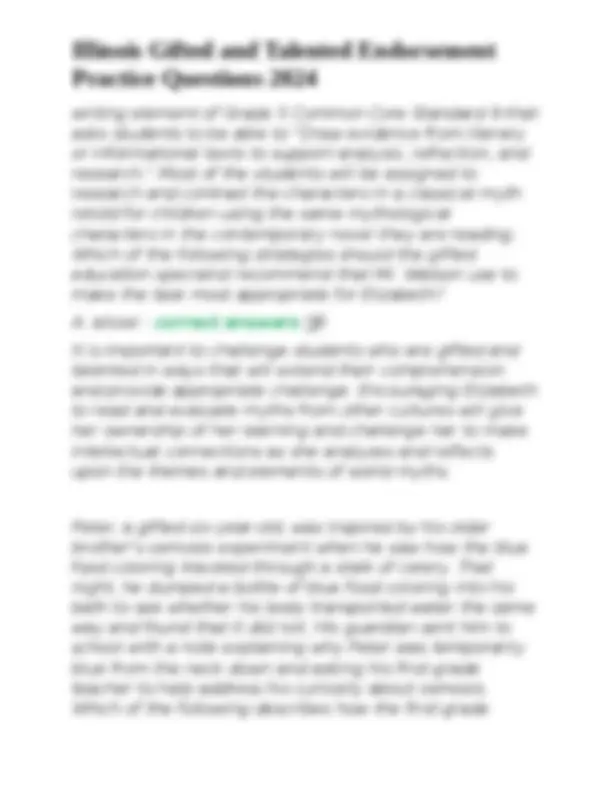
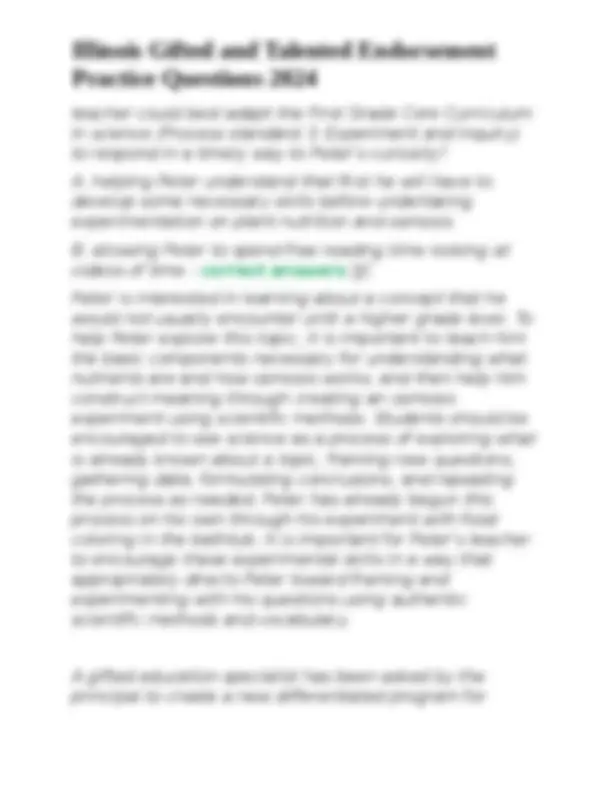
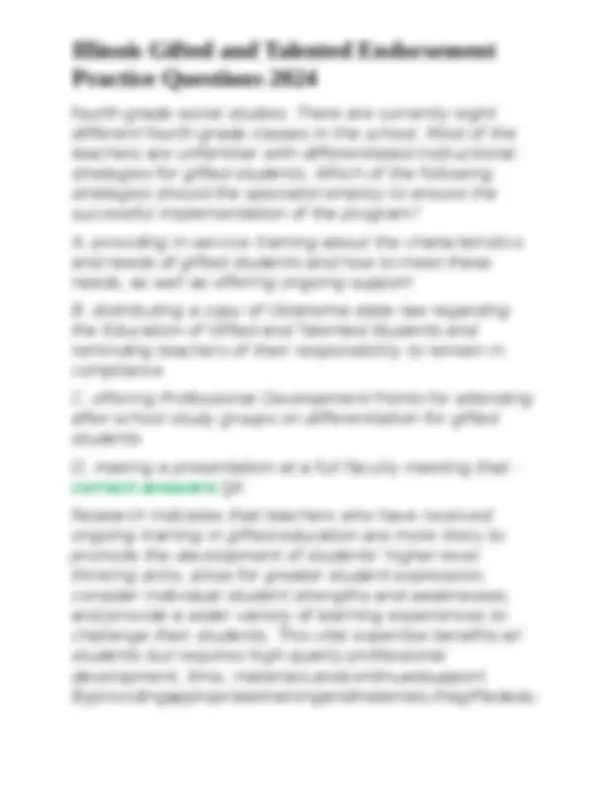
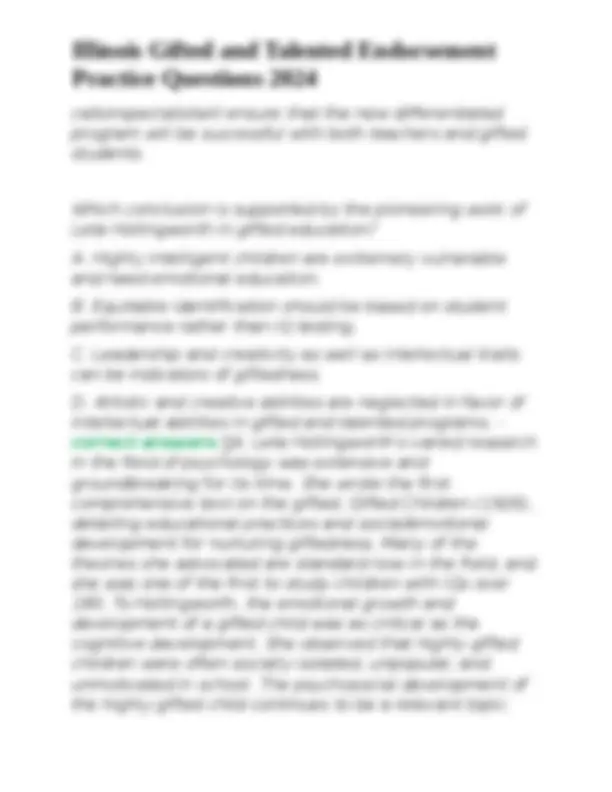
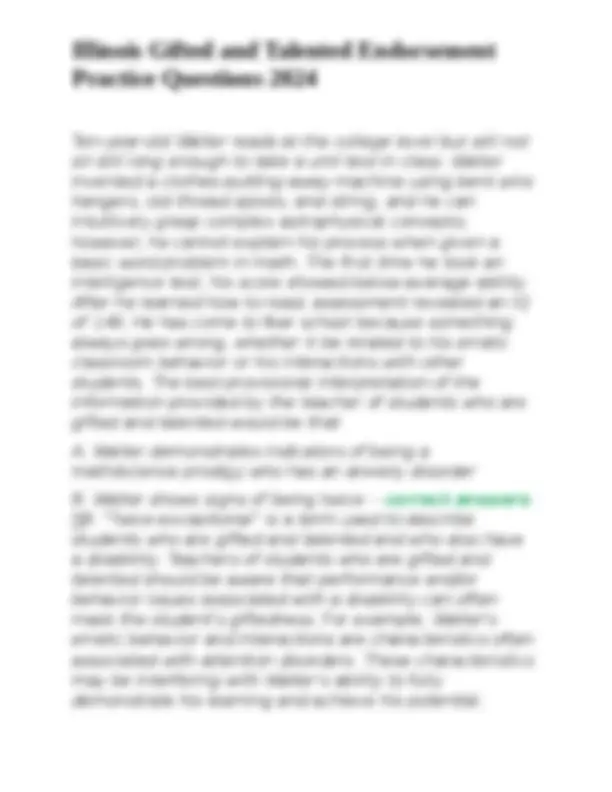
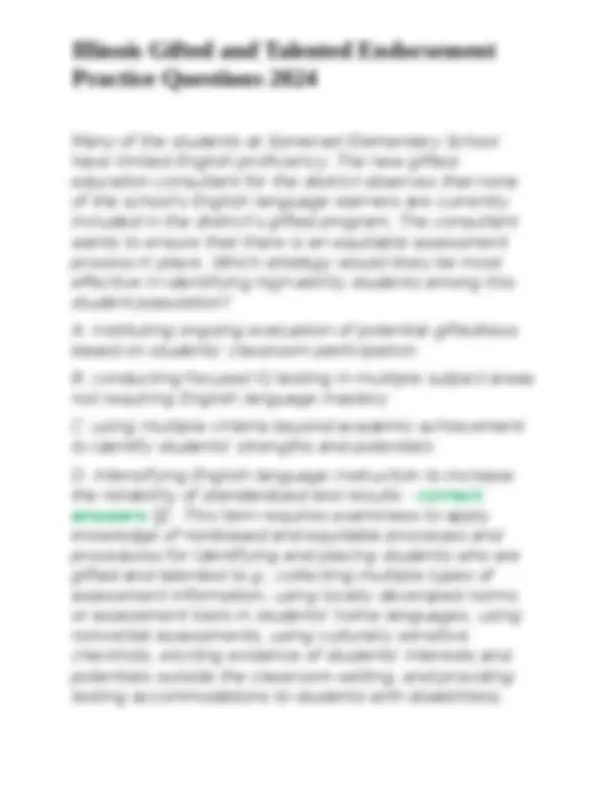
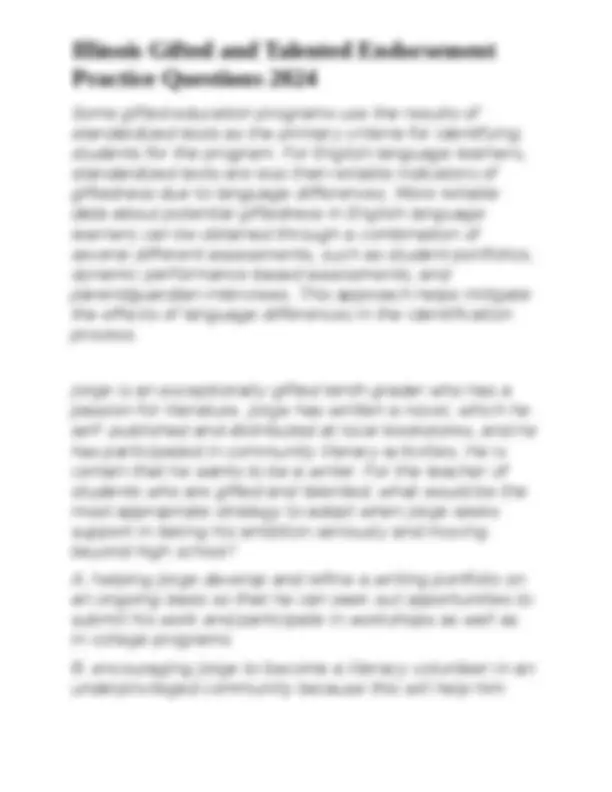
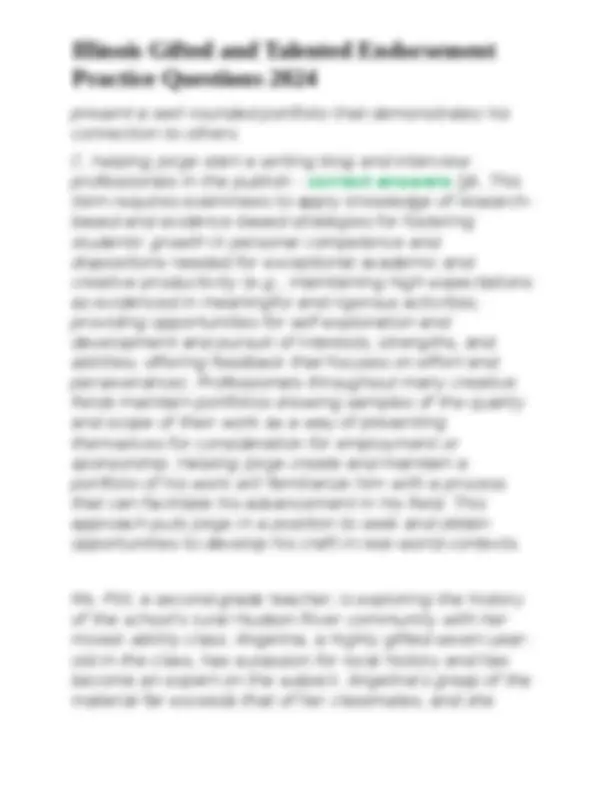
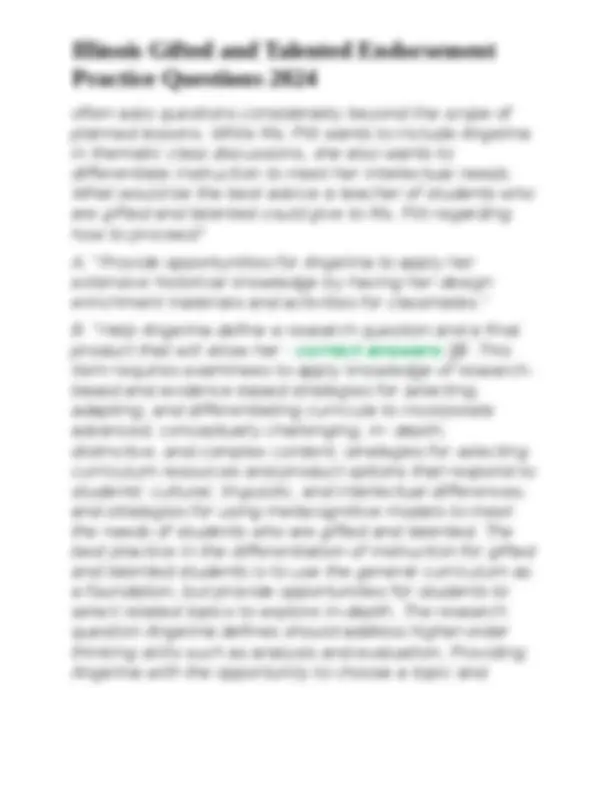
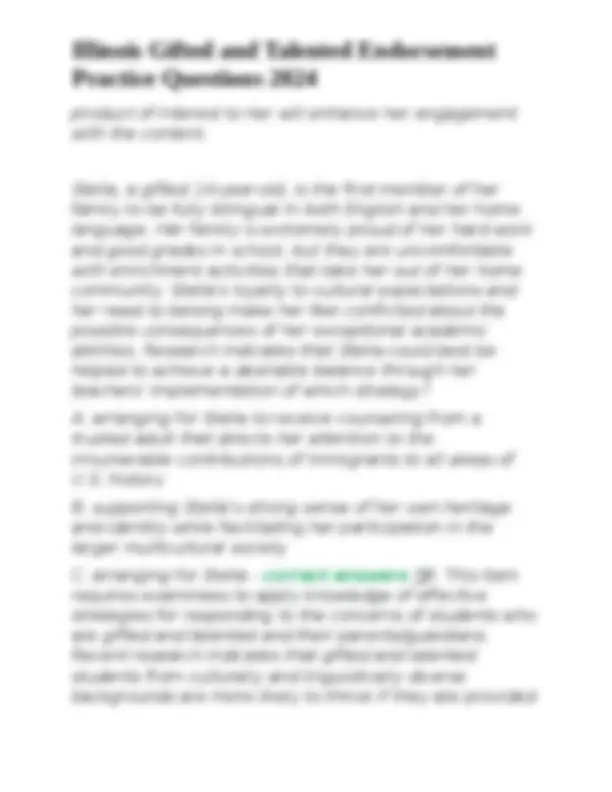
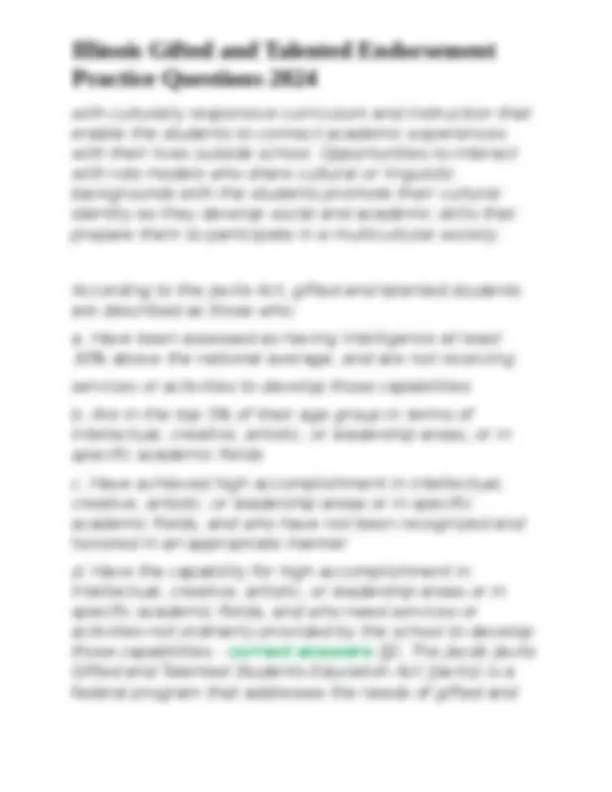
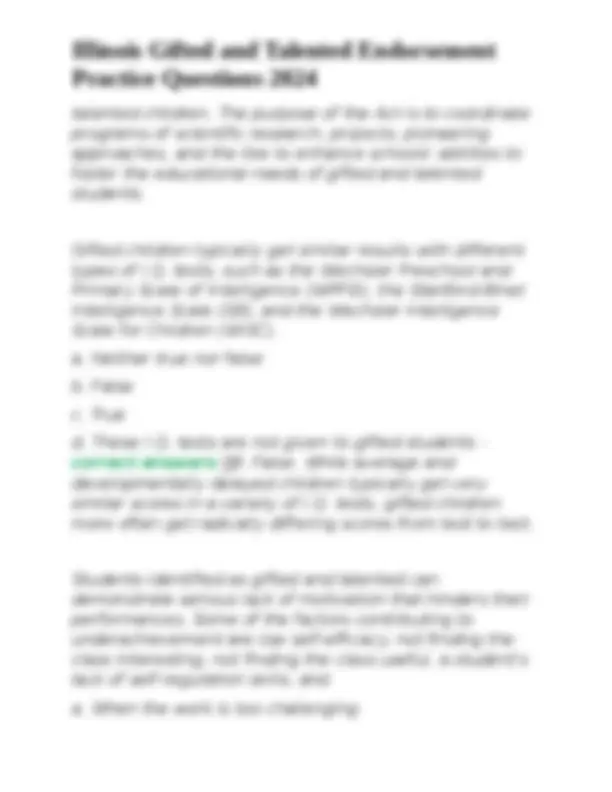
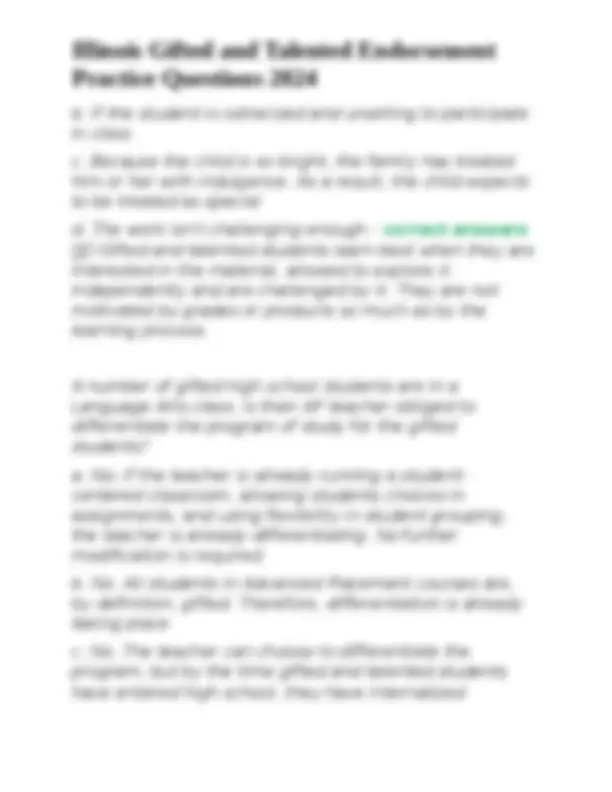
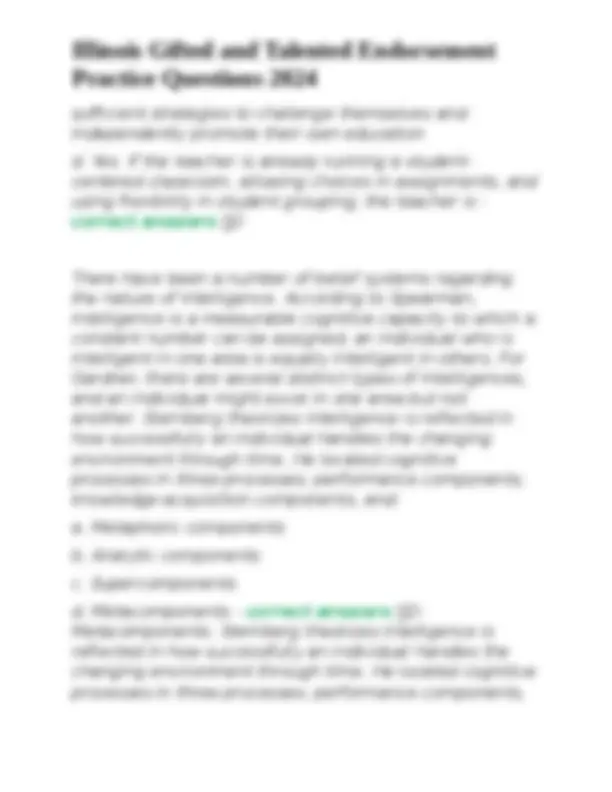
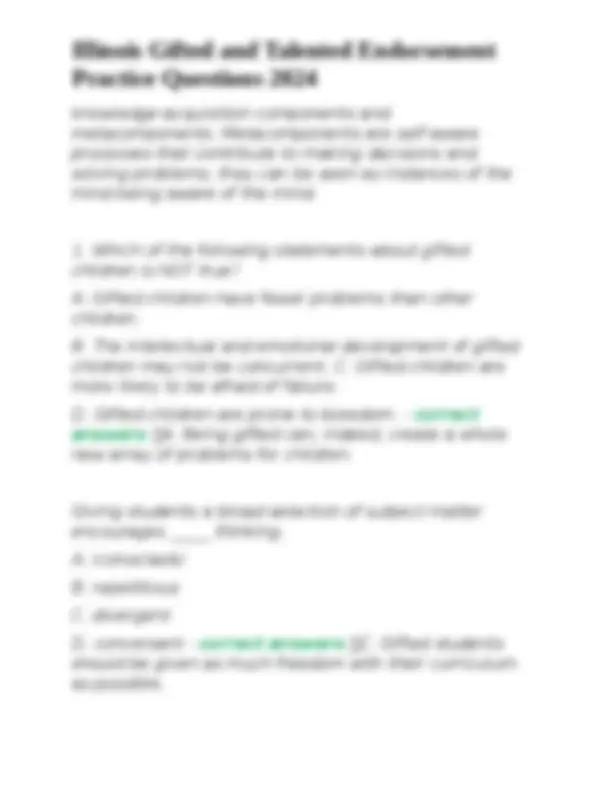
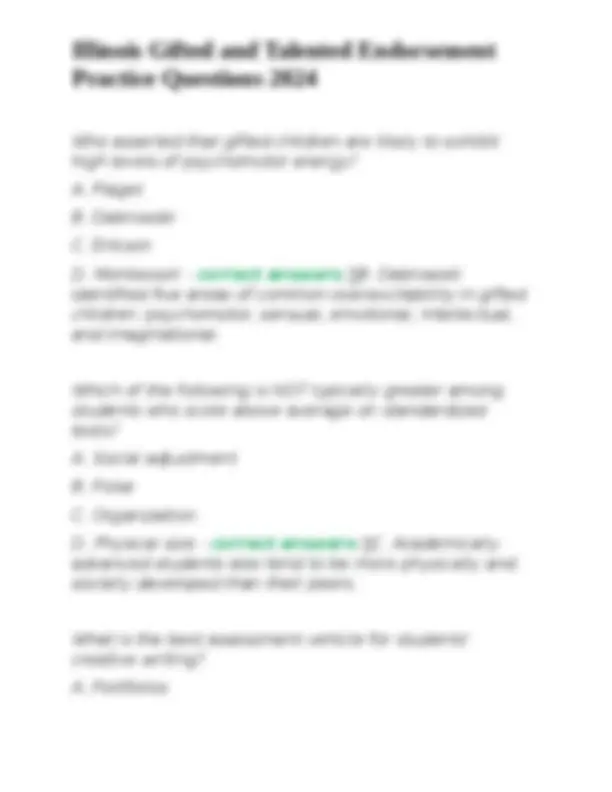
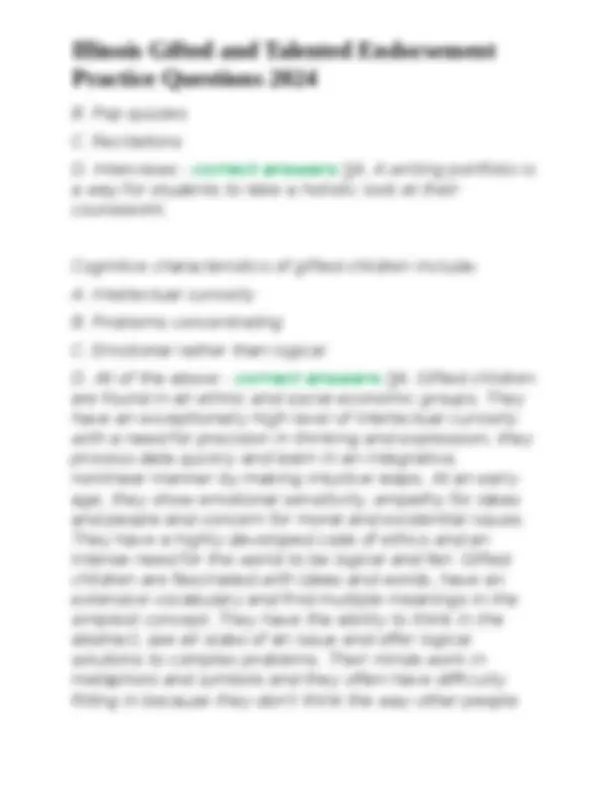
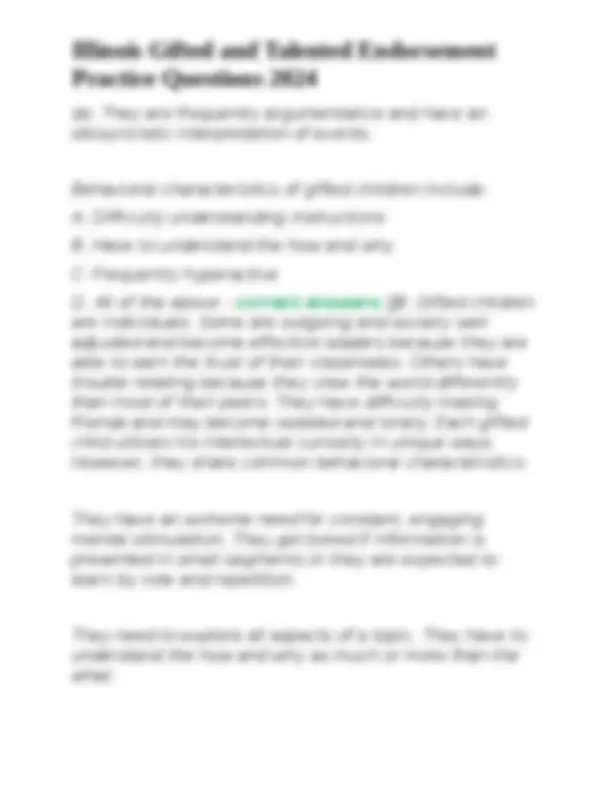

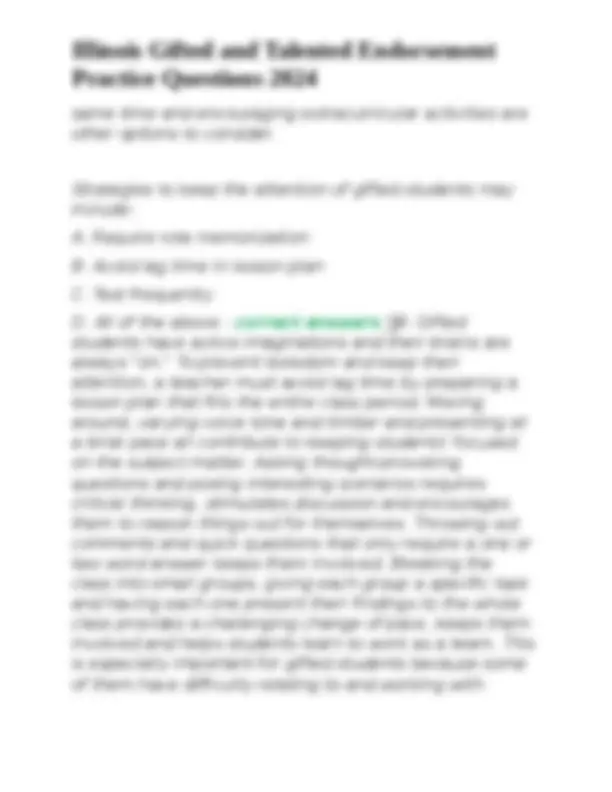
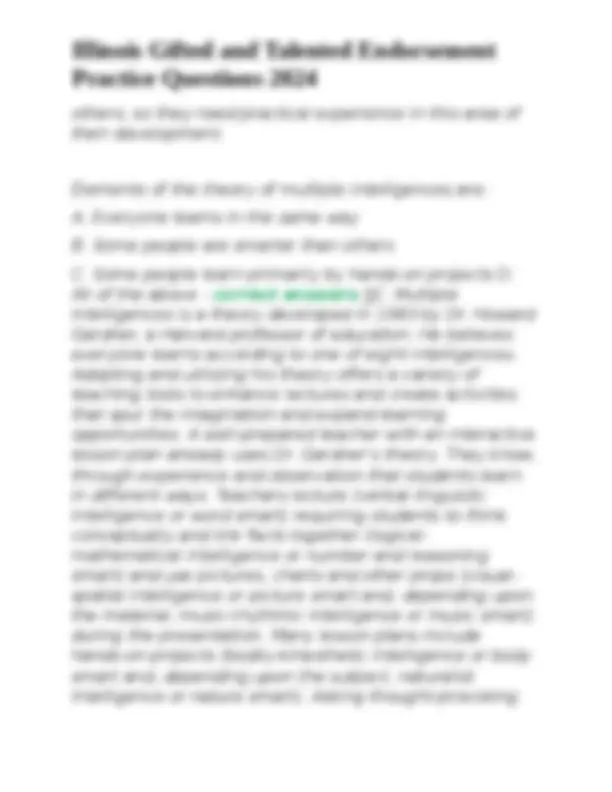
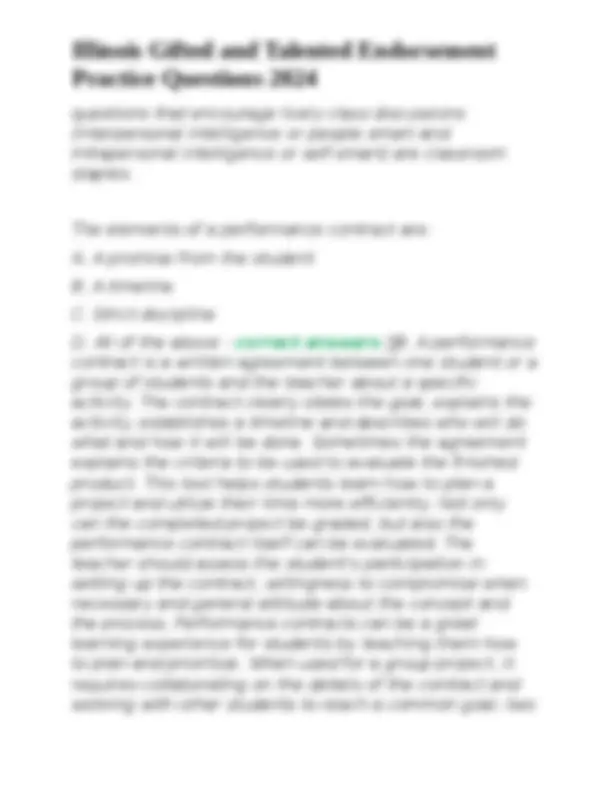
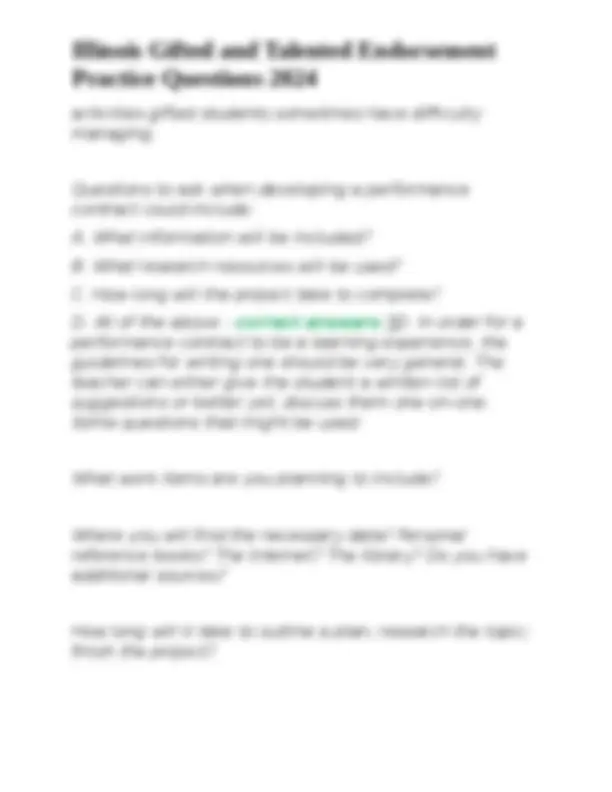
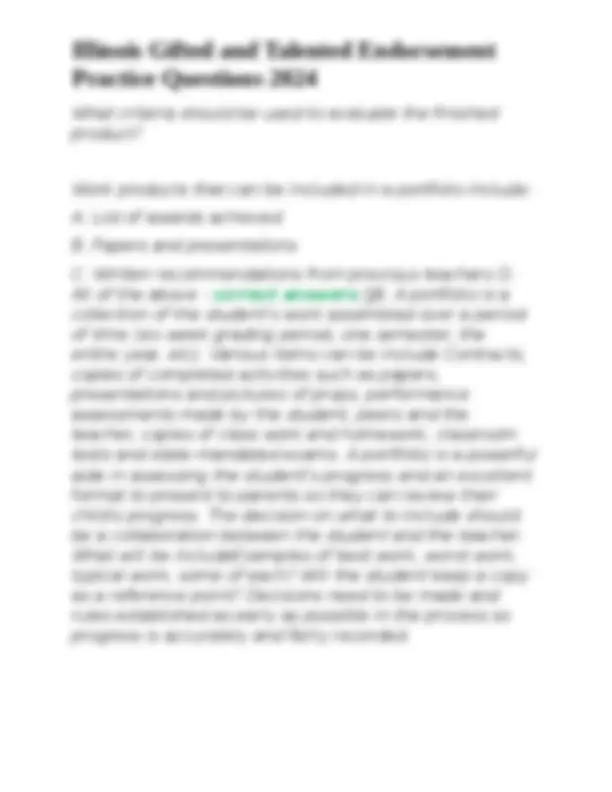
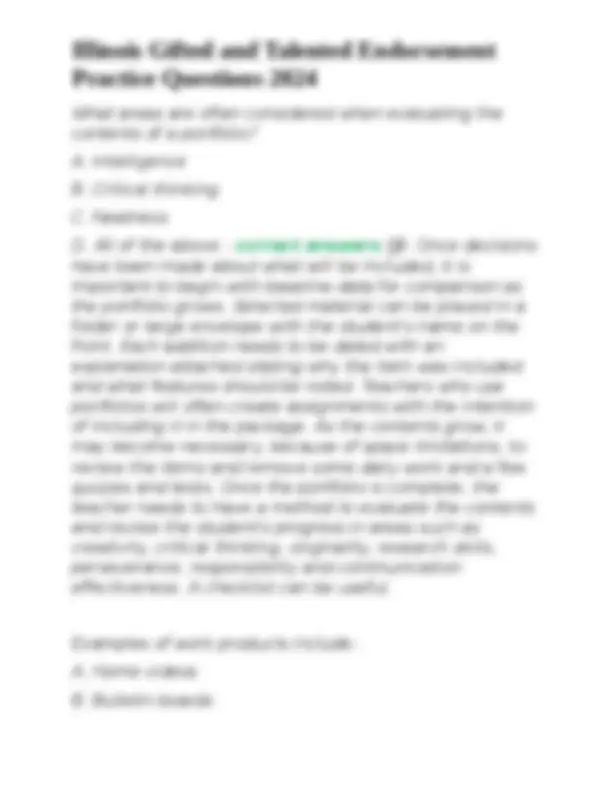
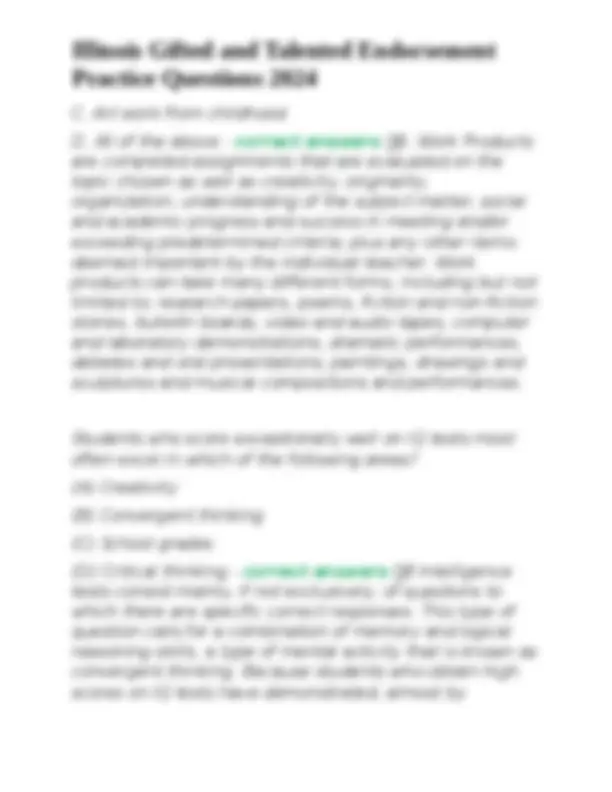
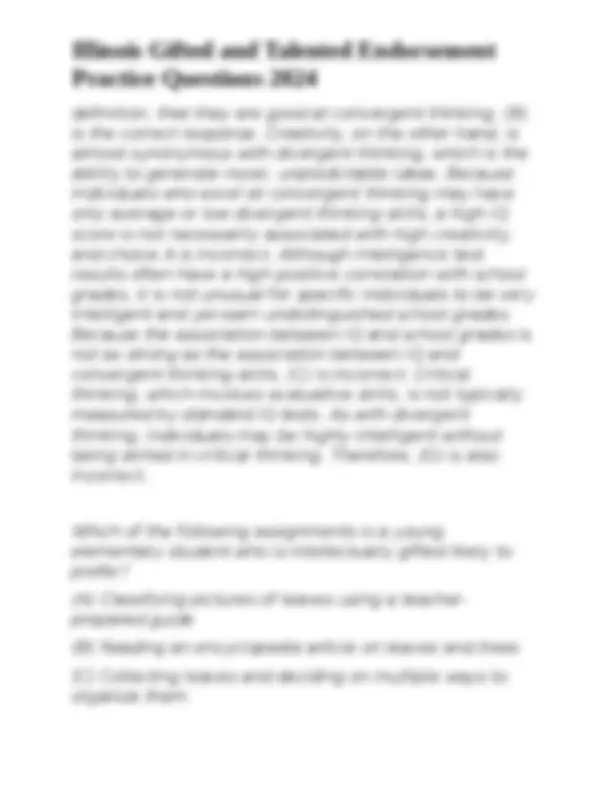
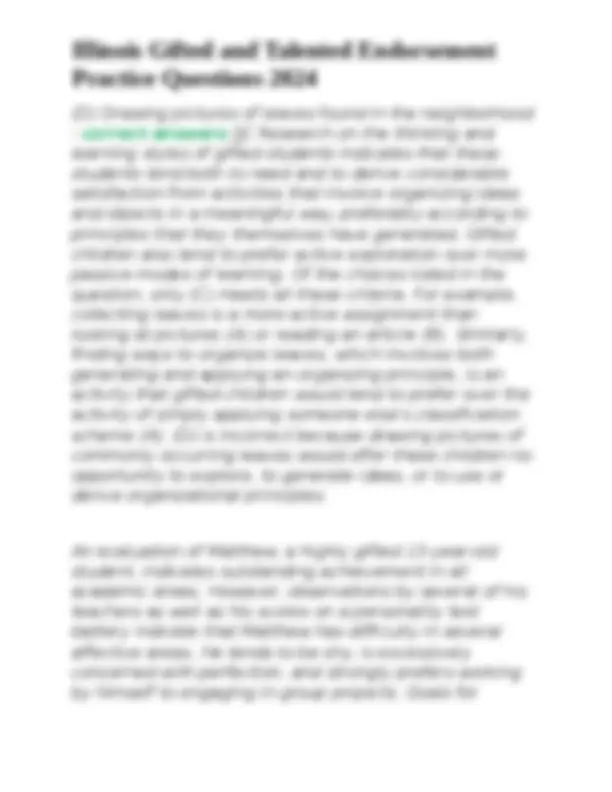
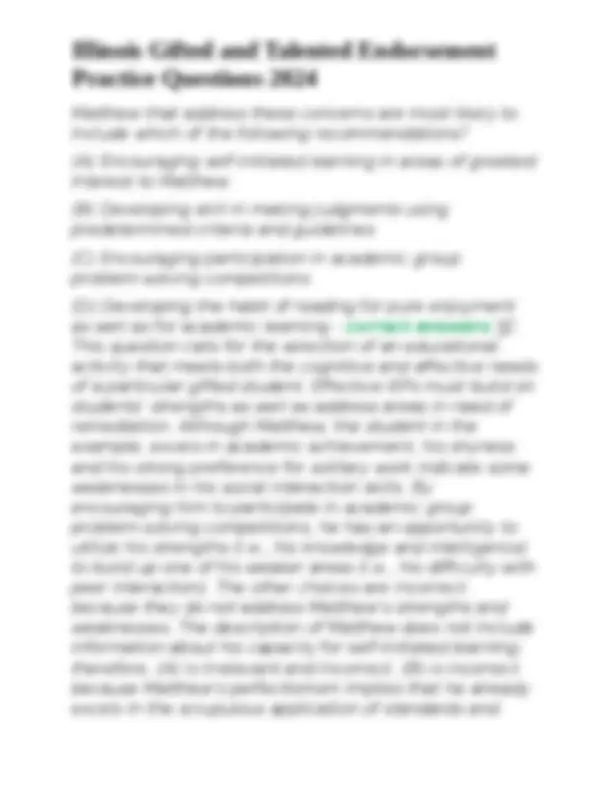
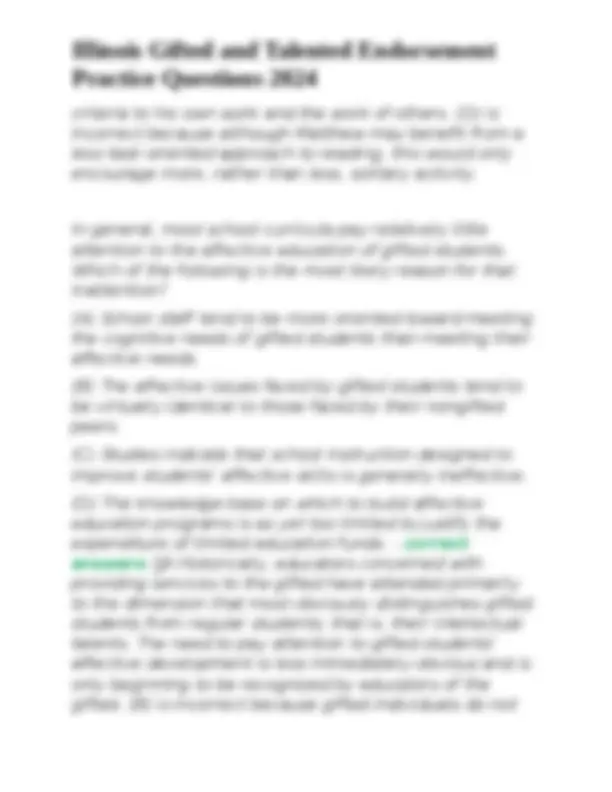
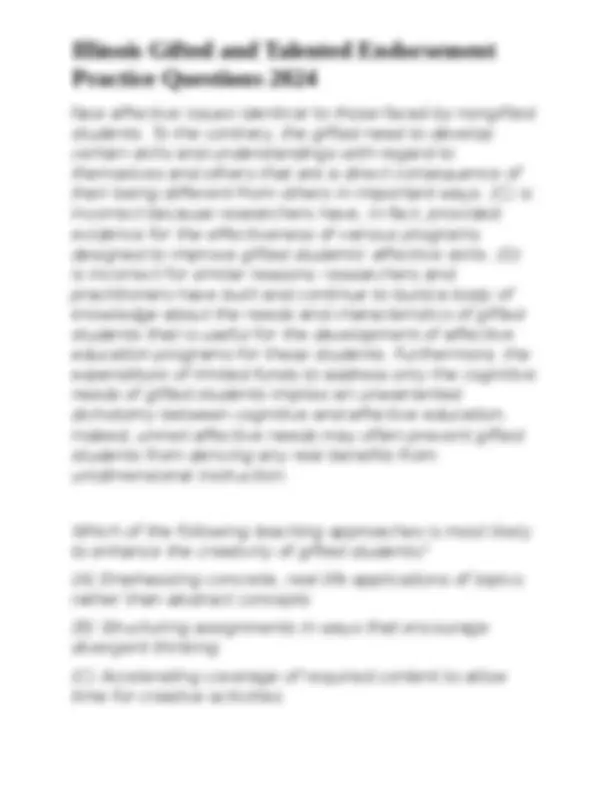
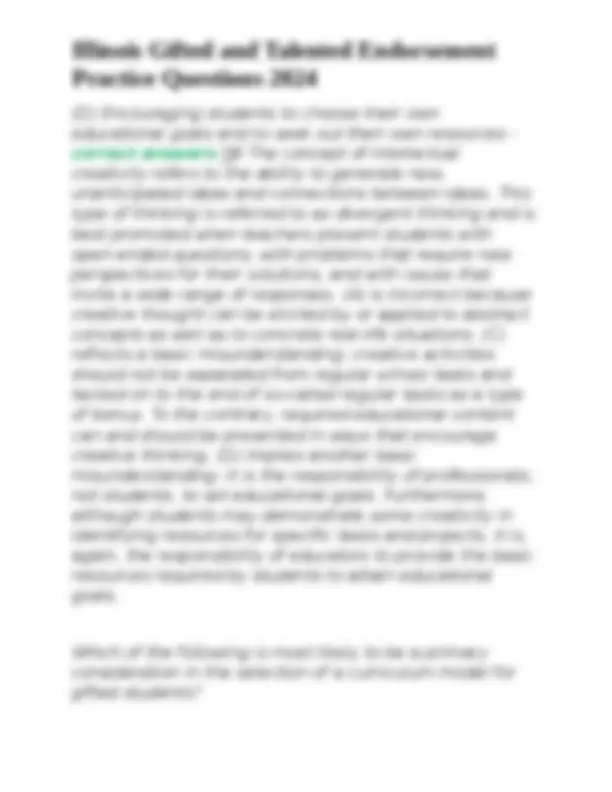
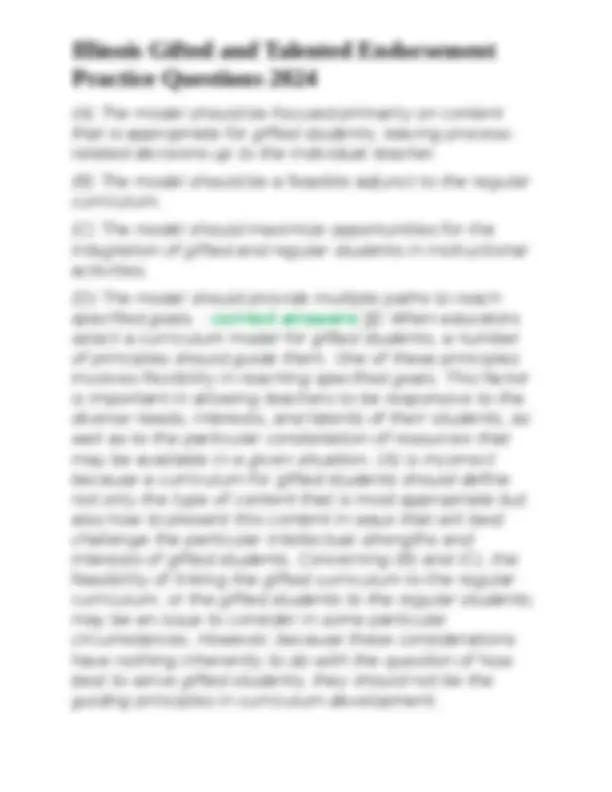
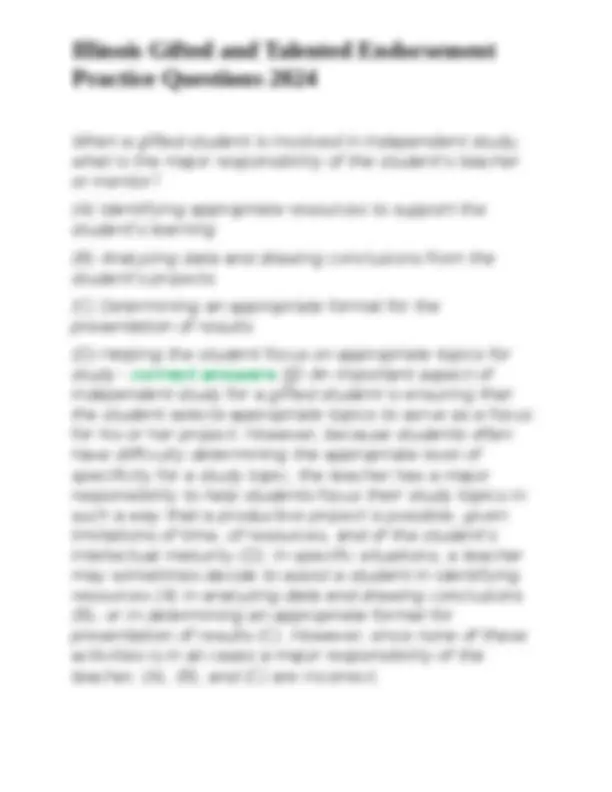
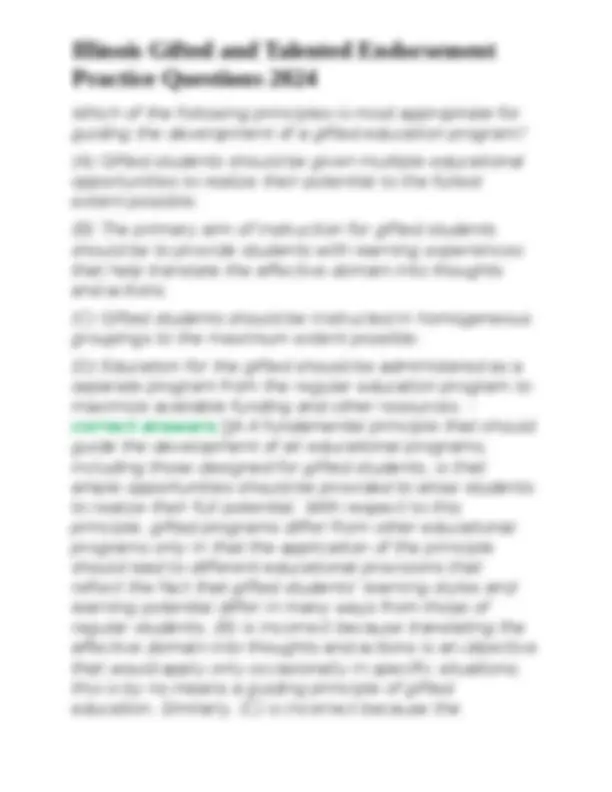
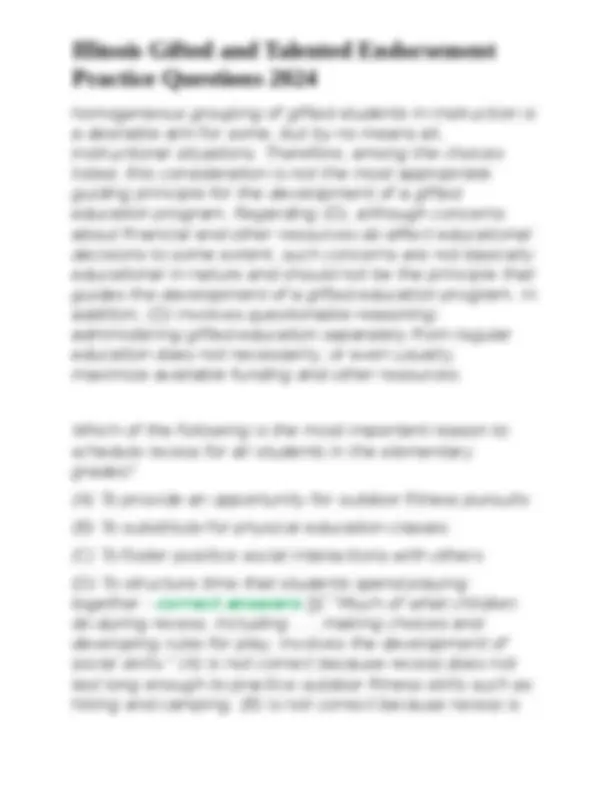
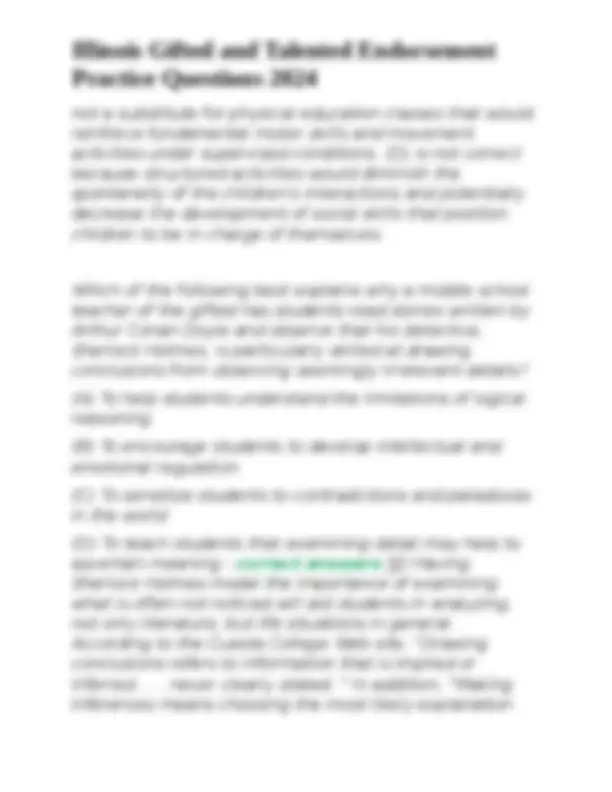
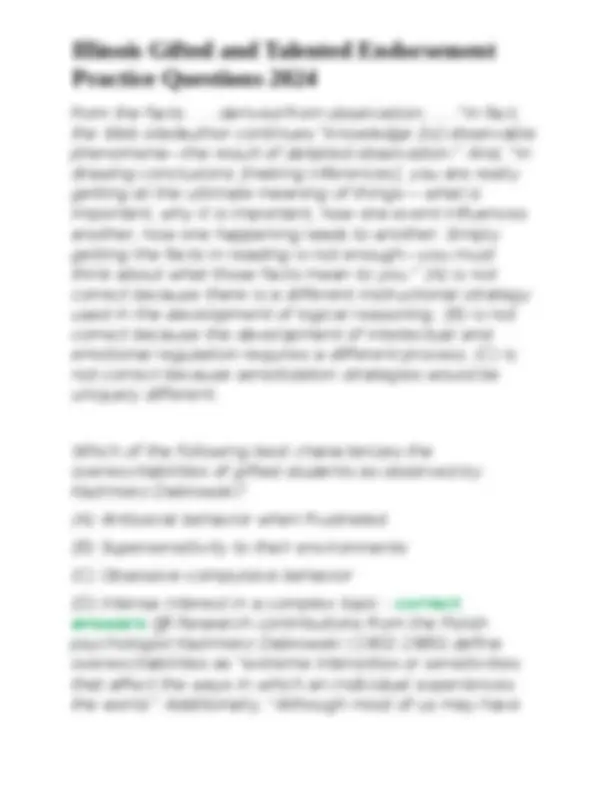
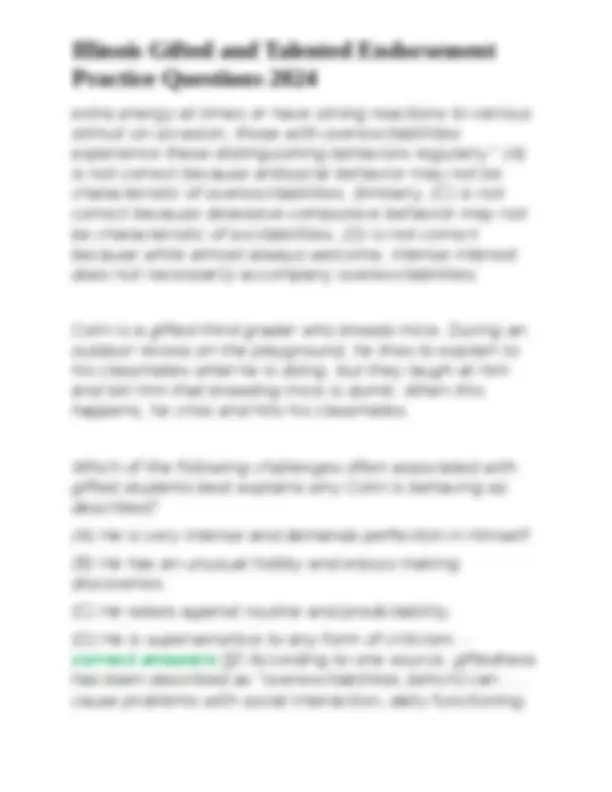
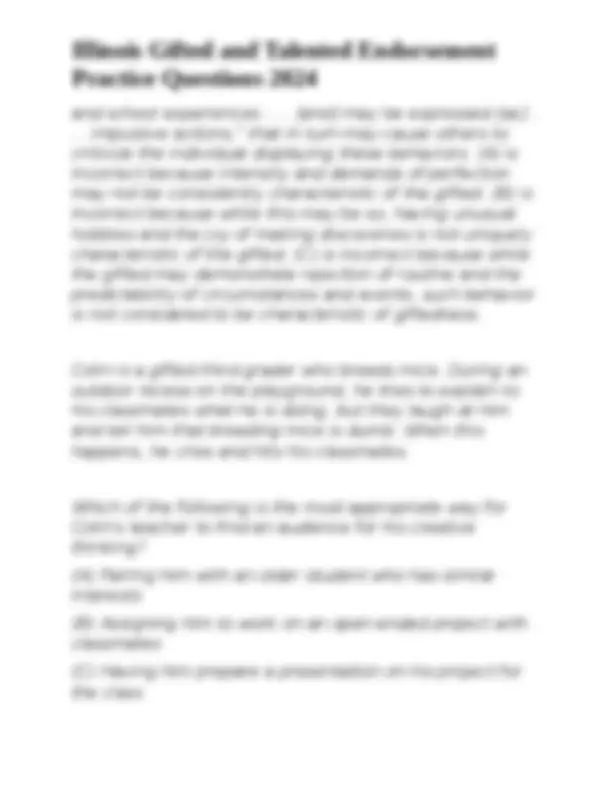
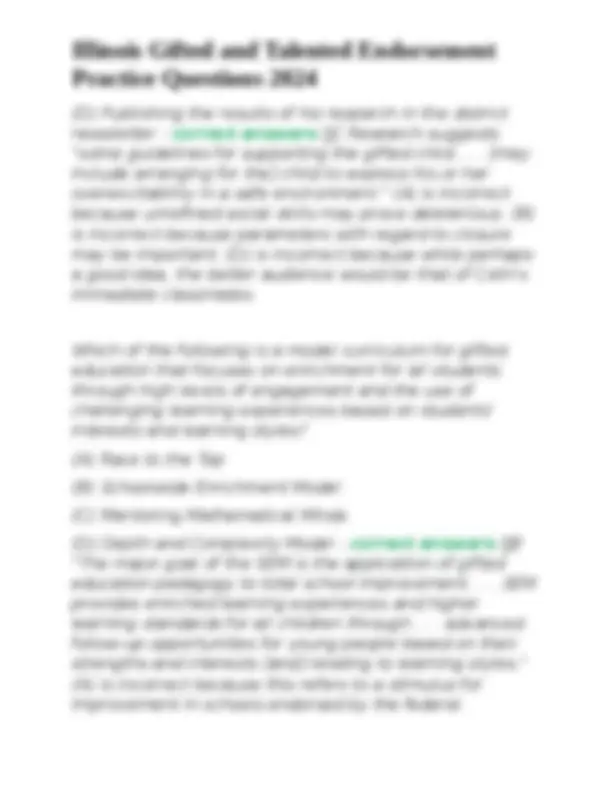
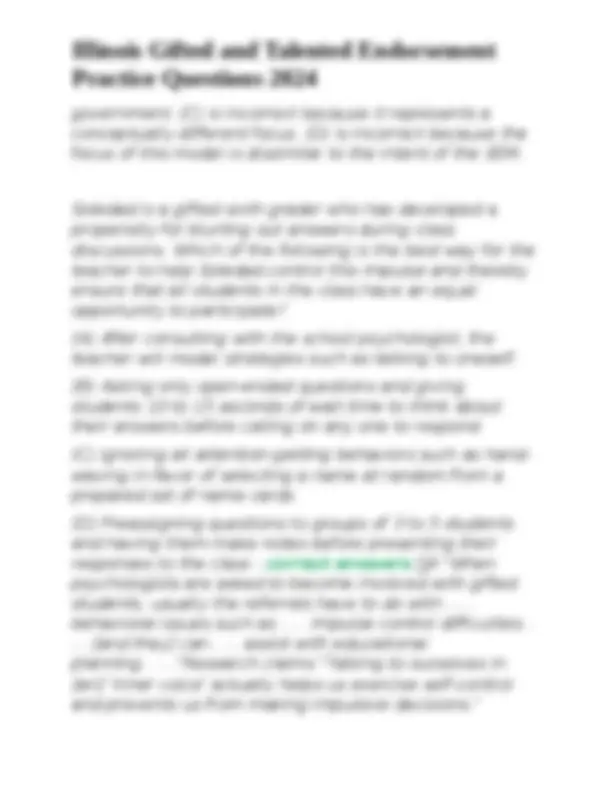
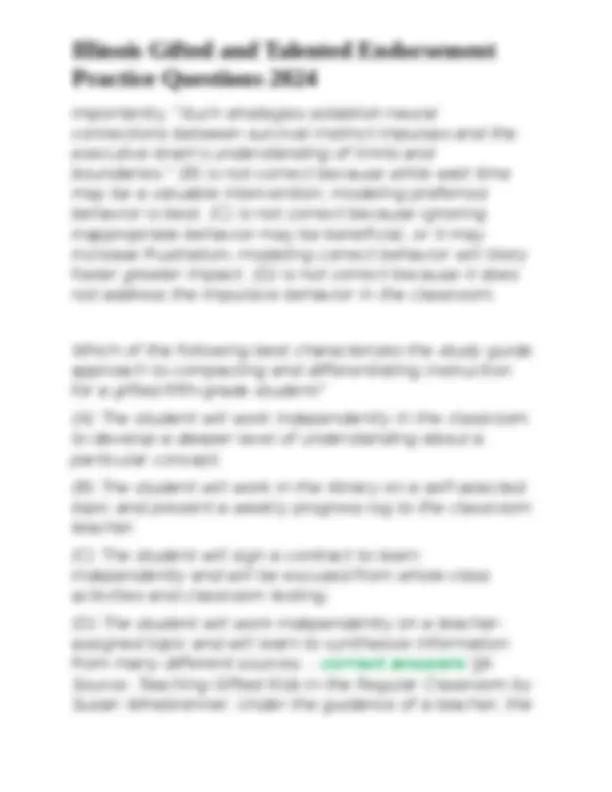
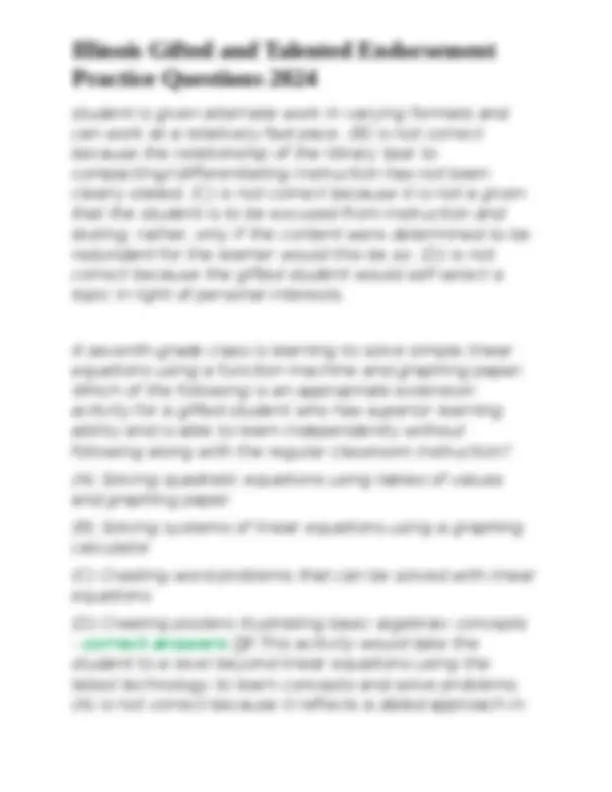
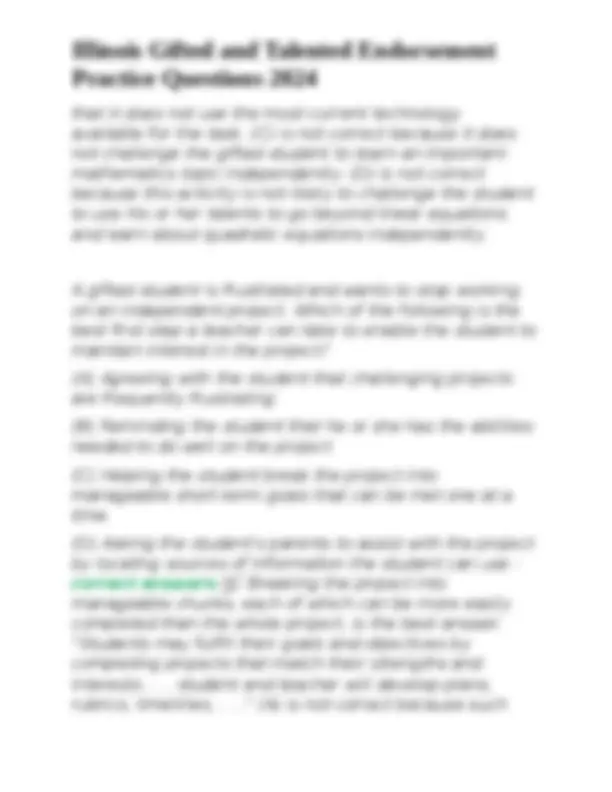
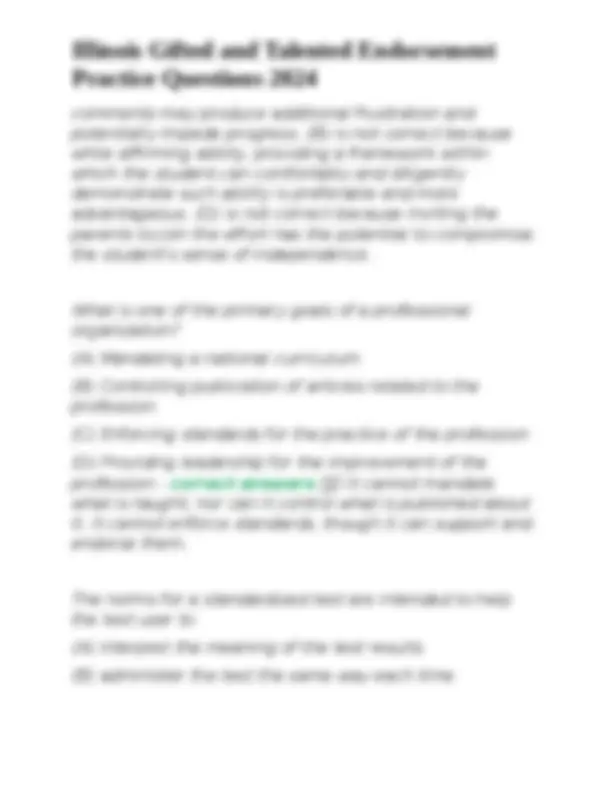
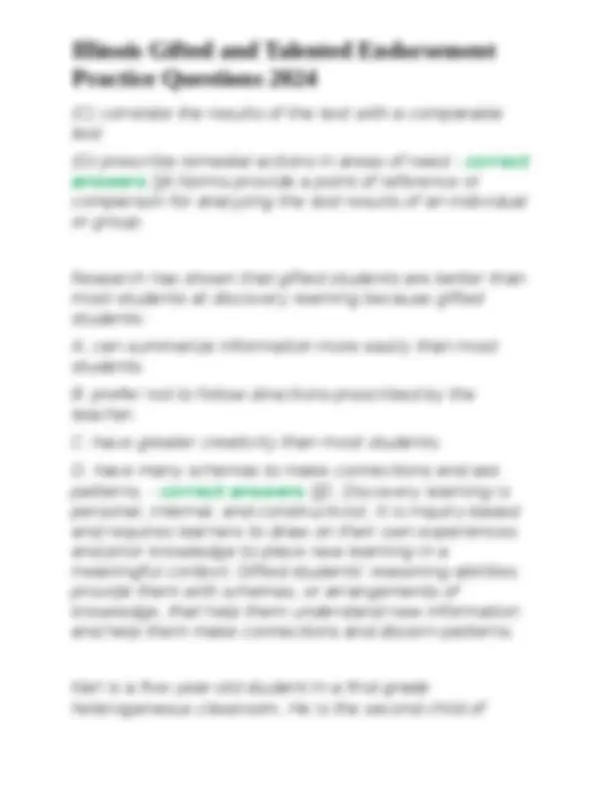
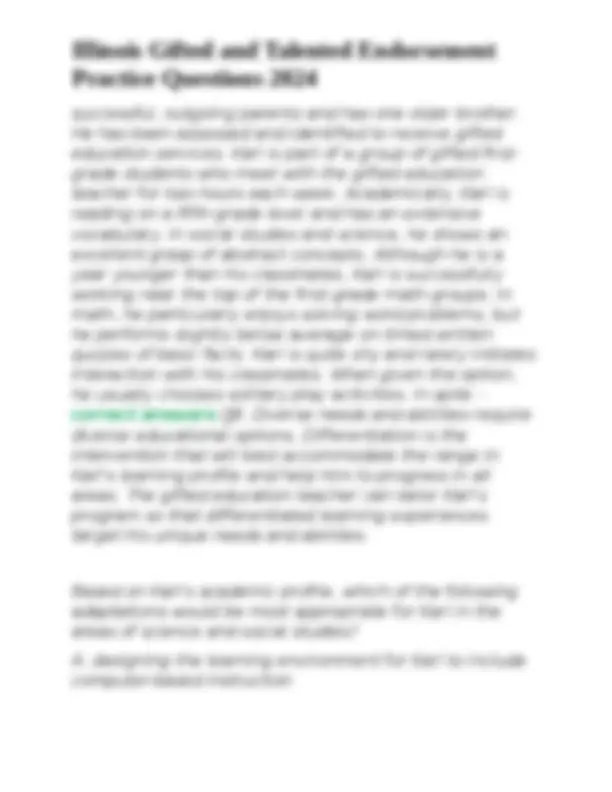
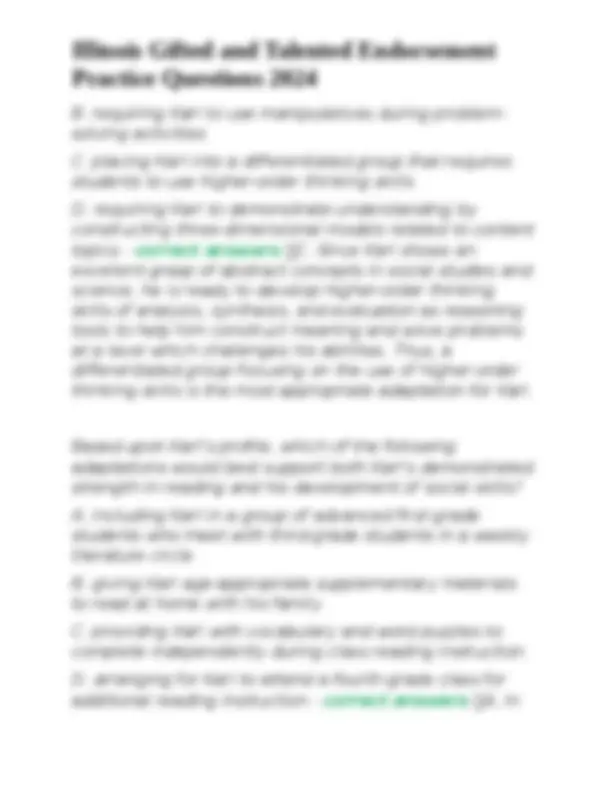
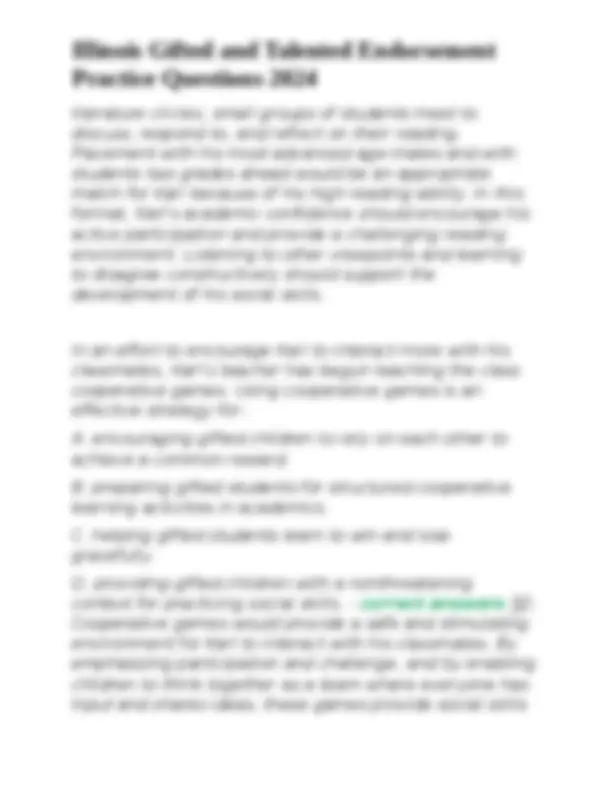
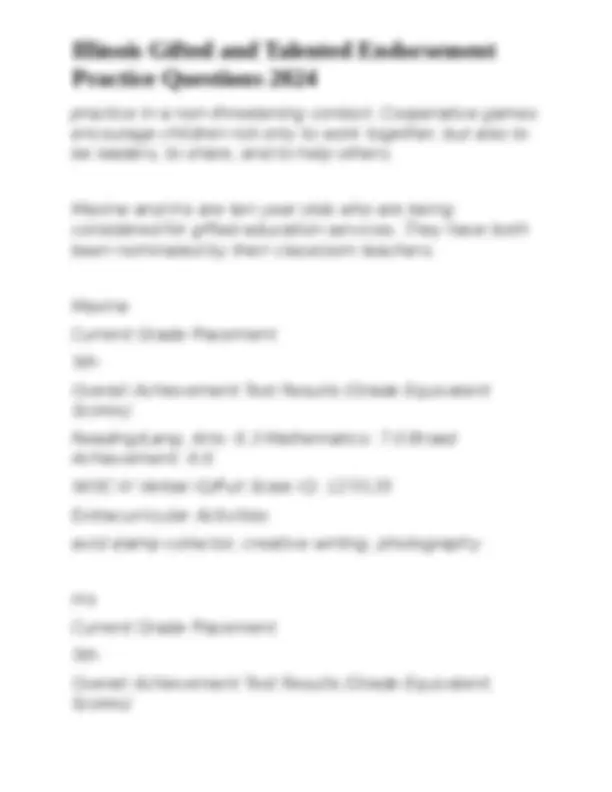
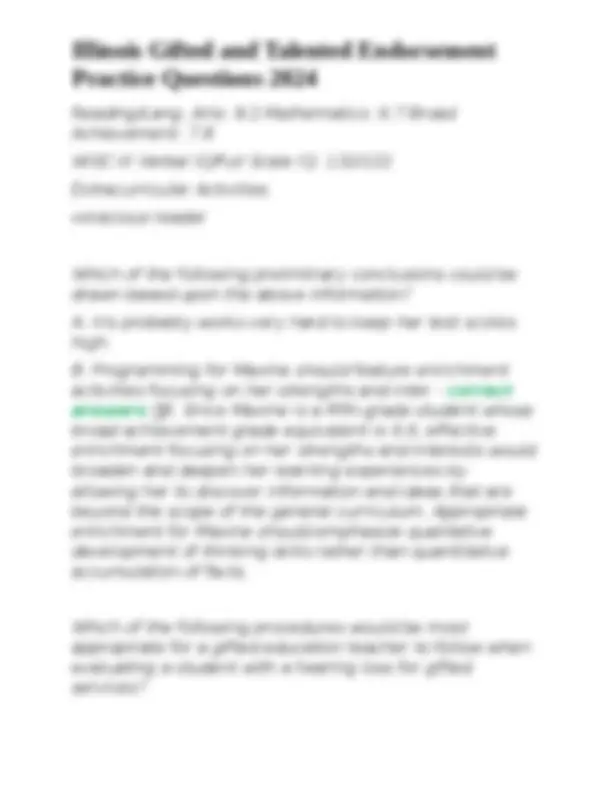
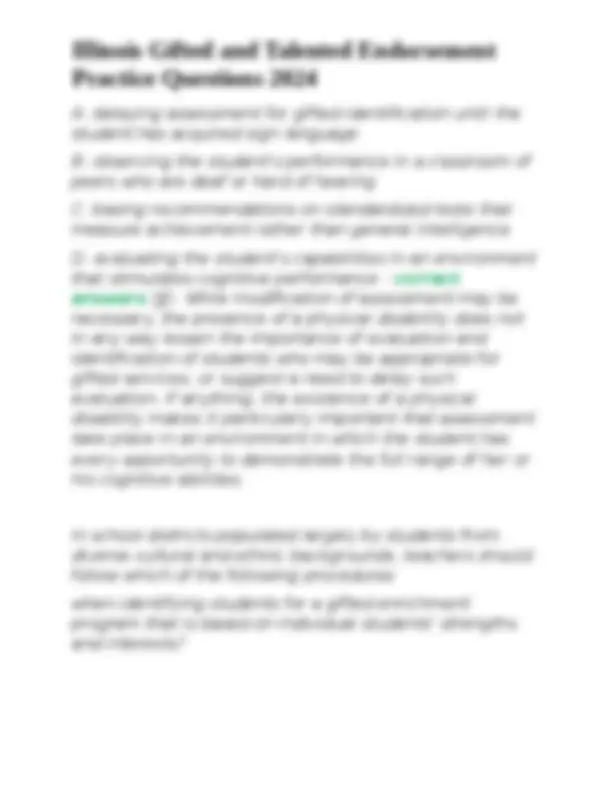
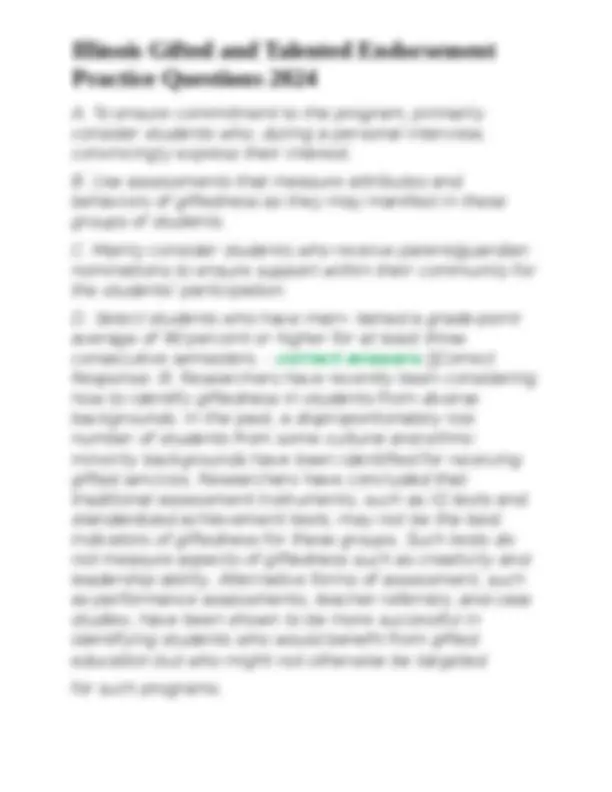
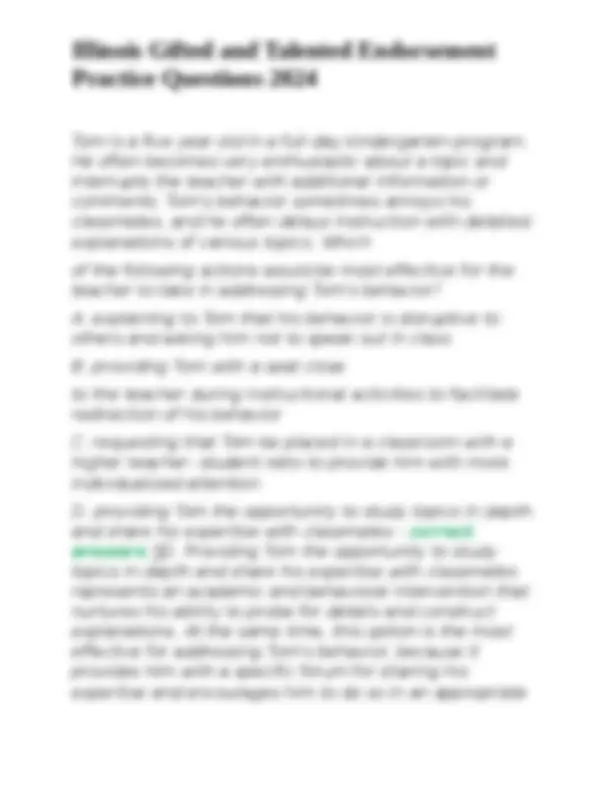
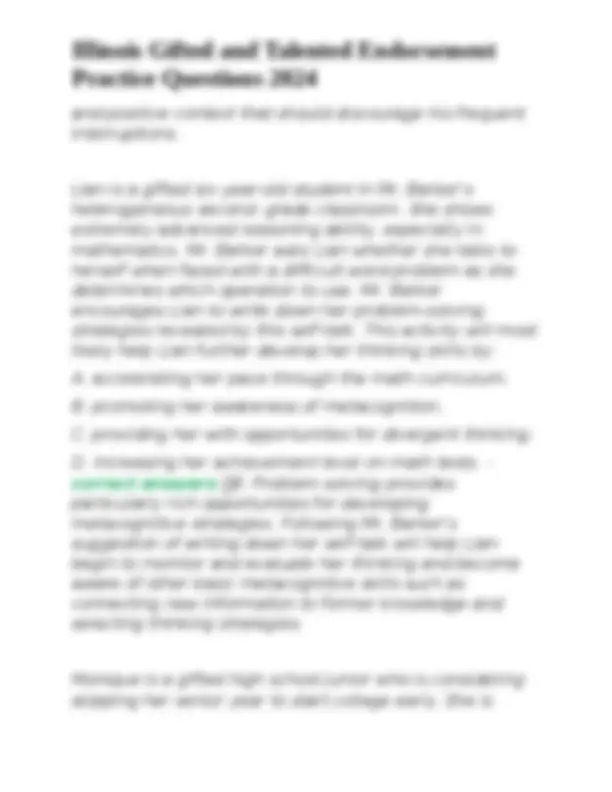
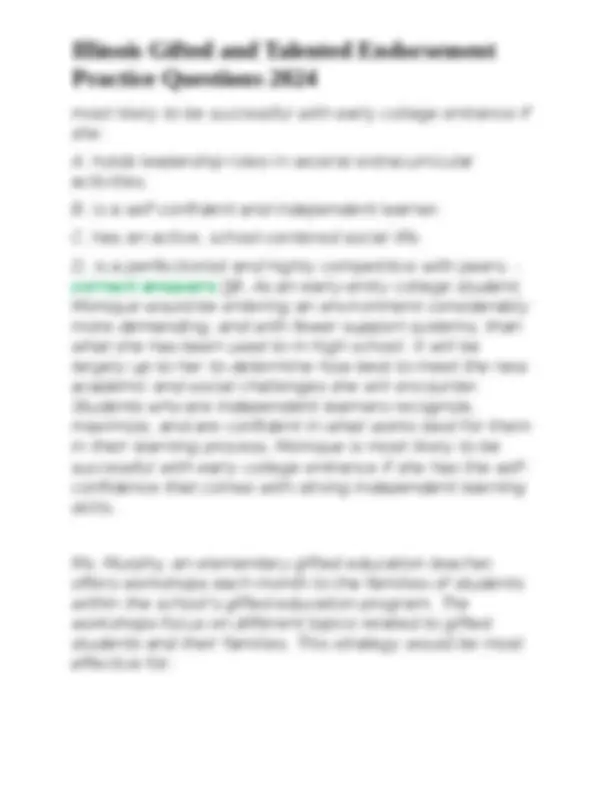
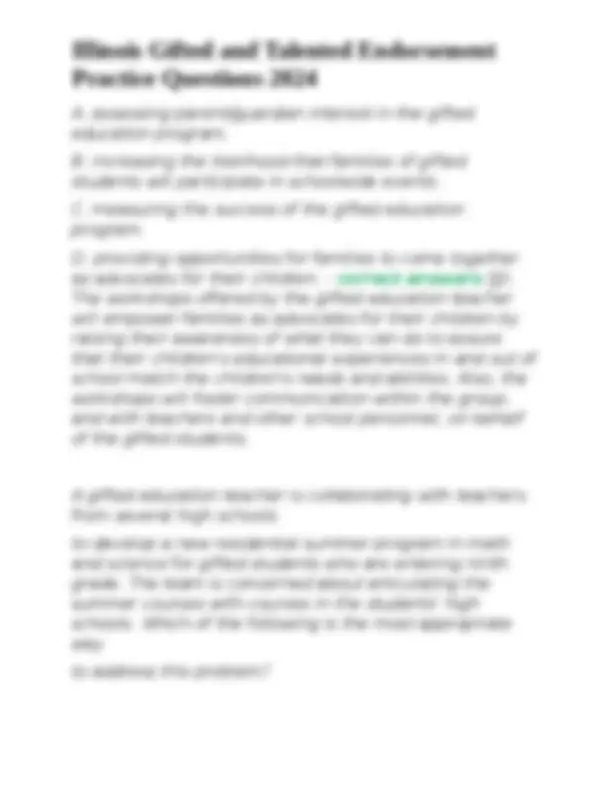
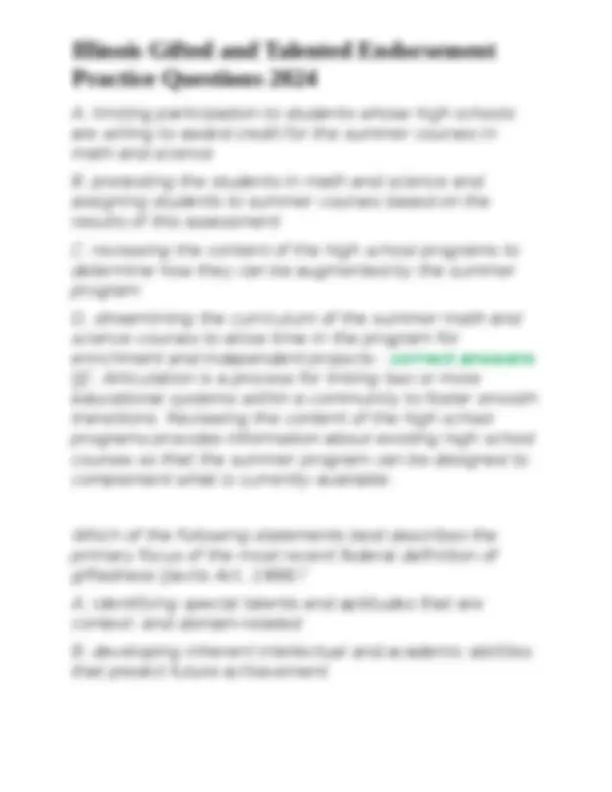
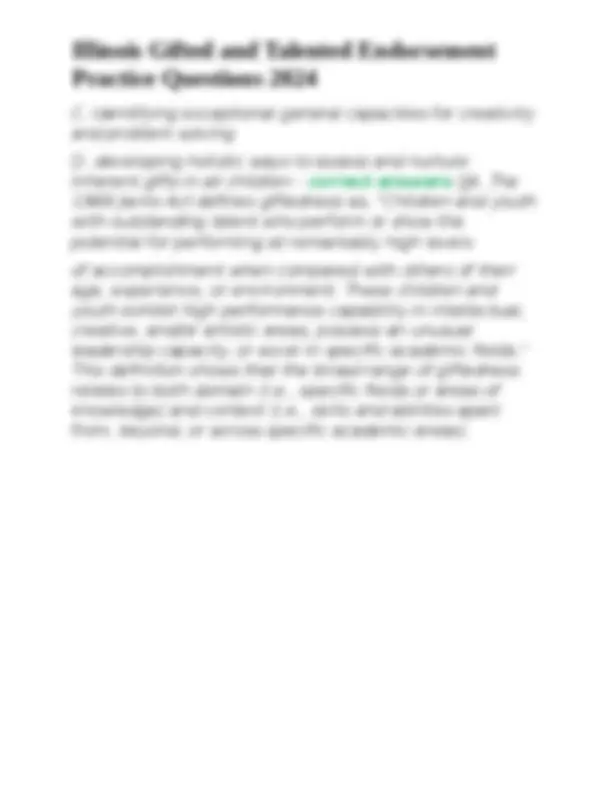


Study with the several resources on Docsity

Earn points by helping other students or get them with a premium plan


Prepare for your exams
Study with the several resources on Docsity

Earn points to download
Earn points by helping other students or get them with a premium plan
Community
Ask the community for help and clear up your study doubts
Discover the best universities in your country according to Docsity users
Free resources
Download our free guides on studying techniques, anxiety management strategies, and thesis advice from Docsity tutors
Practice questions related to the illinois gifted and talented endorsement, focusing on various strategies and approaches to encourage and support gifted and talented students. Topics covered include differentiation of curriculum, accommodating gifted students with learning disabilities, promoting academic advancement, and fostering students' growth in personal competence and dispositions. The questions test examinees' knowledge of research-based and evidence-based strategies for gifted education.
Typology: Exams
1 / 87

This page cannot be seen from the preview
Don't miss anything!
















































































According to research conducted by Carol Dweck, which of the following approaches is most effective for encouraging students who are gifted and talented? A. reminding the students that because they are smart, they will do well on upcoming projects B. delaying gratification to help the students learn to work for longer periods of time C. identifying tasks for the students that are just beyond their current abilities D. acknowledging the students' hard work and effort in meeting identified learning goals - correct answers ✅D. The research of Carol Dweck, PhD, supports the idea that encouragement for hard work and effort, mastery orientation, rather than praise for fixed traits and actions, a performance orientation, actually helps students to embrace challenge and strive to do their best, even when faced with difficult tasks. Dweck's research distinguishes between a fixed mindset, for instance, a focus on innate talent, and a growth mindset or a focus on dedication and resilience. Her research reveals a meaningful difference between creating student dependency on expressions of approval from others and fostering inner direction and a sense of ownership and responsibility for their efforts. An elementary school's new kindergarten teacher says to the gifted education teacher, "I have a delightful class. However, one student never stops asking questions, needs constant intellectual stimulation, and gets
rambunctious when the class does anything that involves step-by-step processes. What should I do?" Given this preliminary information about the student, which of the following statements is the gifted education teacher's most appropriate response? A. "These characteristics sound like the developmental behaviors of a child who is gifted and talented. The student might benefit from differentiated instruction." B. It sounds like the student could be gifted. The situation might be helped if you redirect this energy by allowing the student to help others in class." C. "The student may be gifted but have poor social skills. Try providing the student with guided practice in interacting with classmates." D. "The s - correct answers ✅A. At the elementary level, there are a range of behaviors that are associated with exceptional intellectual ability. A child with a strong sense of curiosity who "never stops asking questions" and "needs constant intellectual stimulation" is displaying two qualities highlighted in the research of Dr. Linda Silverman and others. A child's impatience with step-by- step processes may indicate a visual-spatial learning style, and may also indicate that the child masters material faster than his or her classmates. In this scenario, the most appropriate step for the gifted education teacher to suggest would be to recommend differentiated instructional opportunities as a method of engaging the student and gathering further information regarding the child's learning style, strengths, and needs.
Bonita is a kindergarten student who has been reading since she was three years old. Her parents are concerned that she will not be challenged in her kindergarten class during reading instruction. Which of the following types of assessment would be the gifted education teacher's best first step? A. testing Bonita's reading skills using above-grade-level texts and formative assessments B. having the school's reading specialist observe and assess Bonita's reading ability in class C. requesting an overall evaluation of Bonita's IQ before taking further action on her reading D. performing a miscue analysis while Bonita reads to assess accuracy and comprehension - correct answers ✅A. Informal assessment of Bonita's reading skills using above-grade-level texts, reading program assessments, or formative assessments is an effective way for the teacher of a gifted and talented student to gauge reading level and comprehension skills. It is important to remember that a highly or profoundly gifted child may be able to read several years above grade-level. Assessment using above- grade-level texts will provide the teacher with the student's level of aptitude for higher level decoding skills together with comprehension of text and vocabulary. Differentiation of instruction for Bonita can then be designed for her specific strengths and weaknesses.
Eighth-grade science students will be studying Newton's three laws of motion. Two students in the class who are also in the gifted education program have experience with this topic. The gifted education teacher is collaborating with the classroom teacher to modify existing instructional plans to better promote the learning needs of the students who are gifted and talented while maintaining their involvement in the activity. To develop differentiated instructional plans for these students, the gifted education teacher should first: A. collaborate with the students who are gifted and talented in designing a timeframe that will guide their learning. B. pre-assess the background knowledge of the students who are gifted and talented relevant to the topic to identify and integrate appropriate extension activities during the unit. C. notify the parents/guardians of the students who are gifted and talented about adjustments - correct answers ✅B. All teachers are better able to differentiate instruction by pre-assessing the existing knowledge of the students so that instruction is appropriately challenging and meets academic benchmarks. In this example, since the gifted education teacher is collaborating with the general education teacher to develop a differentiated plan, an informal pre- assessment could be tailored to identify the extent of the students' content knowledge so as to inform instruction as well as plan differentiated extension opportunities.
this stage in his development, not areas of need to be addressed by the gifted education specialist. Tatiana is a sensitive, good-natured, seven-year-old who has been identified as highly gifted. Tatiana is quiet, reflective, does not eagerly participate in class, and prefers quiet and independent activities. She is happy at home, does well in her schoolwork, and enjoys her differentiated activities, particularly if they involve creativity. During a staff meeting, Tatiana's teacher mentions her traits to the school's gifted education specialist and asks, "Should I be doing more to help correct her tendency toward introversion?" Which of the following would be the gifted education specialist's most appropriate response? A. "We should not rule out learning disabilities. It is possible that her intelligence has masked the need for a further assessment." B. "Many children who are gifted and talented are introverted. Introversion is not a flaw, but rather an aspect of her personality." C. "She's still a little girl and s - correct answers ✅B. According to the Duke University Talent Identification Program's Digest of Gifted Research, the majority of gifted children are introverted, and because of their heightened awareness of themselves and others, they are also likely to be "sensitive." Parents and teachers can be supportive of an introverted child by being empathetic
about feelings of shyness and respectful of his or her personality rather than trying to change it. A classroom climate that welcomes the diversity of all students' learning styles and academic strengths and needs may boost the student's involvement and social behaviors. Mr. Allen is a new middle school principal who is interested in knowing more about how to incorporate the Schoolwide Enrichment Model (SEM) to develop more opportunities for students who are gifted and talented. He learns both the school and community provide various Type 1 enrichment activities for students who are gifted and talented, including field trips to the local museum. However, he feels the school could do more to provide these students with Type 2 enrichment activities. Which of the following activities is an example of a Type 2 enrichment activity? A. collecting money to buy books for preschools in impoverished areas B. attending a minicourse on prominent local historical figures C. studying primary resources from the era represented in a historical novel D. listening to an interview with an expert on Shakespeare before watching a performance - correct answers ✅C. The Schoolwide Enrichment Model, or SEM, developed by Joseph Renzulli and Sally Reis of the Neag Center for Gifted Education and Talent Development,
differentiation plan for gifted and talented students. In addition to incorporating the Common Core Standards, the teacher will still need to address the learning needs of students who are gifted and talented by means such as pre-assessment, incorporation of metacognitive and higher-level thinking strategies, and curricular material above grade-level. A science teacher is collaborating with the gifted education specialist to write appropriate science curricula for moderately to highly gifted elementary school students. Which of the following instructional approaches would be most effective for meeting a variety of individual learning needs in science? A. a technology-based program that emphasizes high- level content and depth B. a module-based curriculum that includes pre- assessments to determine student entry level C. a higher-level secondary school curriculum modified to meet elementary school time and staffing constraints D. a range of learning objectives and experiences that emphasize inquiry, higher-level conceptual thinking, and problem-based learning - correct answers ✅D. There is considerable difference between the abilities and learning needs of a moderately gifted child and a highly gifted child. The teacher of both moderately and highly gifted students will encounter a range of individual learning needs, skills, and aptitudes within the gifted
population. By selecting learning experiences that emphasize inquiry, higher-level conceptual thinking, and problem-based learning, the content and learning targets can be appropriately differentiated according to student need, interest, and ability. Carlos, a sixth-grade student, exhibits originality in both oral and written expression, and he is most challenged by tasks that require him to take an alternate point of view. His teachers often describe him as an individual who does not mind being different from the crowd. His grades fluctuate depending on the class and the topic. The characteristics Carlos exhibits are most similar to those of a student gifted in: A. general intellectual ability B. leadership C. a specific academic ability D. creative thinking - correct answers ✅The characteristics exhibited by an individual who is gifted in general intellectual ability include the following: learns rapidly, processes information in complex ways, is excited about new ideas, is a self-starter, is inquisitive, and is an avid reader. The characteristics exhibited by an individual who is gifted in leadership include the following: assumes responsibility, has high expectations for self and others,
enrichment program. He is currently investigating possible locations and resources for the program. B. Mr. Cabrera's fourth-grade students are involved in independent research projects. He meets with students on a weekly basis to discuss their progress and provide them with resources and guidance as needed. C. Mr. Cabrera attends a school board meeting to present information about the need to increase services for gifted students in the district. He cites findings from current research in the field to support his argument. D. Mr. Cabrera has recently read several articles about a new instructional technique to use with gifted - correct answers ✅Option A describes a situation in which Mr. Cabrera is working together with other gifted education teachers to develop a new program. In this role, Mr. Cabrera is collaborating with others to reach a goal. Therefore, he is serving in the role of a COLLABORATOR rather than as a facilitator. Option B describes a situation in which Mr. Cabrera's students are involved in independent research projects. He meets with his students weekly to discuss their progress and to provide support in the form of resources and guidance. During these projects, Mr. Cabrera provides a learner-centered environment in which he serves as a support and guide rather than as an authority figure; he enables students to pursue their own learning goals. Therefore, he is serving in the role of a
FACILITATOR. Thus option B would be the correct response to this item. Option C describes a situation in which Mr. Cabrera attends a school board meeting to present information about the need to increase services for gifted students in the district. He presents an argument in favor of expanding services for gifted students. Therefore, he is serving in the role of an ADVOCATE rather than as a facilitator. Option D describes a situation in which Mr. Cabrera has read several articles about a new instructional technique to use with gifted and talented elementary students. He decides to conduct action research by using the technique with his students on a trial basis and analyzing the results. Therefore, he is serving in the role of a RESEARCHER rather than as a facilitator. Gifted students with learning disabilities can often be distinguished from other students with learning disabilities, because when gifted students with learning dis- abilities are faced with a challenging task that aligns with their strengths and interests they most often: A. attempt to complete the task as quickly as possible. B. become distant from and uncom- municative with the teacher and classmates. C. tell the teacher they are unable to complete the task.
D. She is focused and intense when learning. - correct answers ✅D A gifted seventh-grade student takes a twelfth-grade standardized test designed to measure math aptitude and receives a score equal to the mean for college-bound seniors. When communicating these test results to the student's parents/guardians, the gifted education teacher should emphasize that the student: A. has mastered most of the content of high school math courses. B. is extremely proficient in test-taking skills. C. has exceptional ability in math-related analytical reasoning. D. is capable of passing college-level math courses. - correct answers ✅C A gifted education teacher is constructing a summer science course in problem solving for gifted middle school students who demonstrate verbal and quantitative reasoning ability at least two years above grade level. The teacher plans to measure student achievement with an intensive final written exam and presentation. The teacher could most effectively use formative evaluation to promote student performance at advanced levels by: A. reviewing data on individual student performance as a basis to support giving competitive awards.
B. studying systematically collected data on student performance to modify and revise the curriculum. C. analyzing data on low student performance to determine the need for reassessing any student's eligibility. D. collecting data on exceptional student performance to support a proposed course sequel. - correct answers ✅B Which of the following is the most important reason for using multiple forms of assessment when screening for giftedness in children with disabilities? A. The nature and impact of disability-related developmental delays may affect performance on a standard instrument at a given time. B. Stereotypical attitudes about twice exceptional individuals may affect the way in which standard assess- ments are administered. C. Educators' lack of training in addressing dual exceptionalities may affect educators' ability to evaluate individual performances. D. The shortage of specific identification instruments for those with disabilities may affect the interpretation of scores. - correct answers ✅A During the second quarter of the school year, a kindergartner seems bored and easily distracted,
A. scope and sequence development B. curriculum alignment C. single-subject differentiation D. curriculum compacting - correct answers ✅B A gifted education teacher is planning programs for the identified gifted and talented students in a middle school. Within the school, there are children of various ages identified with specific gifts in each of the four content areas, as well as in overall intellectual abilities, in the arts, and in leadership abilities. Given these variables, which of the following is most important for the teacher to consider when planning appropriate program options for each of the students? A. Individual programs must be based on one specific area of giftedness. B. Programs must primarily serve those students with specific gifts in each of the four core academic content areas. C. Programs must enable gifted and talented students to work together as a group, with other students, and independently. D. Individual programs must include after-school and summer enrichment opportunities. - correct answers ✅C
Ms. Shah, a high school gifted education teacher, gives her students in advanced science an essay test that asks them to explain how to apply problem-solving skills to a science issue of their choice. She expects student responses to be related to ecology, the focus of their first- semester study, and she is impressed by the rich array of issues raised by the students in their essays. Because of the students' expressed interest in and depth of thought about diverse issues, Ms. Shah decides to replace the whole-group single- issue investigation she had planned for the second semester with guided independent study projects. Which of the following best explains the reason for Ms. Shah's decision? A. She wants students to sharpen their critical-thinking ability by examining multiple viewpoints. B. She evaluates group dynamics and believes that students will create diverse, productive outcomes. C. She wants students to le - correct answers ✅D Tyrone is a quiet third-grade student with a gift for writing who is educated in a heterogeneous classroom. He spends much of his free time writing plays with well- defined characters and plots, and he shows many of these plays to his teacher, Ms. Moore, who is impressed with their overall quality and depth of character development. Which of the following strategies would be most effective for Ms. Moore to use in providing an appro- priate audience for Tyrone's work?